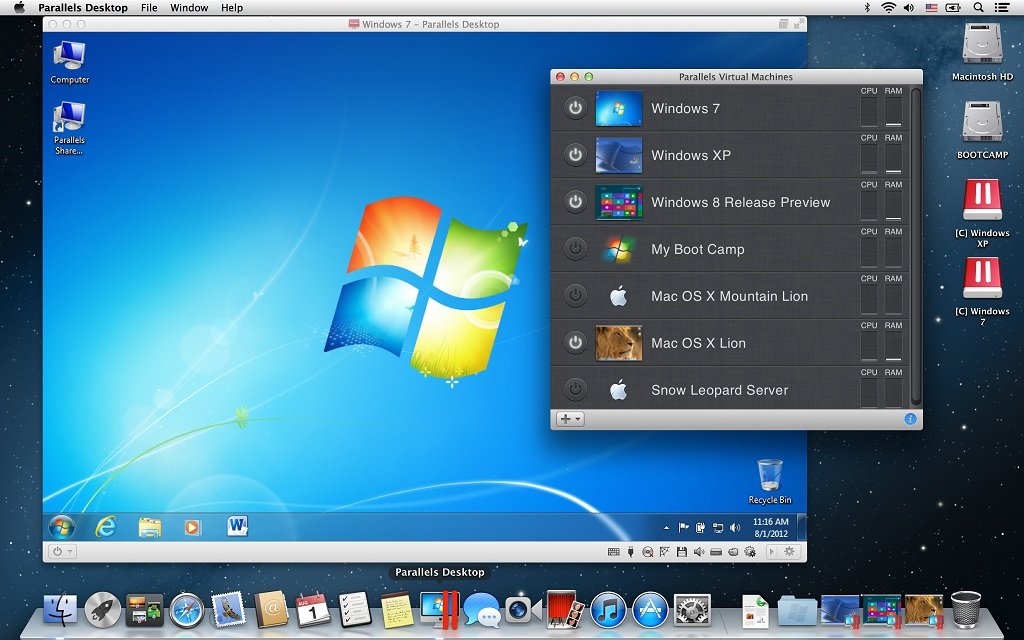
Parallels desktop for mac - opinion
Screenshots
Description
Parallels Desktop® App Store Edition is a fast, easy and powerful application for running Windows both on a Mac with the Apple M1 chip and a Mac with an Intel processor - all without rebooting.
NOTE: It is not recommended that existing Parallels Desktop for Mac users move to Parallels Desktop App Store Edition.
Parallels Desktop Installation Assistant helps you to get up and running in a few minutes. Powerful performance lets you run many Windows apps on your Mac, including games and CAD programs.
FEATURES:
- Download and install Windows in two clicks.
- Share Mac folders with Windows—including Desktop, Documents, and Downloads.
- NEW: Drag and drop text or graphics between macOS and Windows apps.
- NEW: Enhanced desktop, video, and gaming experience with a higher refresh rate.
- NEW: Use the Trusted Platform Module 2.0 device in Windows.
- 3D graphics acceleration up to DirectX® 11.1.
- Copy/paste formatted text and files between macOS, Windows, and Linux.
- Drag and drop files and images between macOS, Windows, and Linux.
- Resize the window to get the desired Windows or Linux resolution.
- Use Mac printers in Windows and Linux.
- Connect USB devices to Windows and Linux.
- And many more...
PRICING:
- Creating and editing virtual machine configurations is available for free.
- Running virtual machines requires an in-app purchase of an auto-renewable subscription (1 year). You can cancel at any time.
- There is a fully functional 14-day trial to test Parallels Desktop before the subscription starts.
SUPPORTED OPERATING SYSTEMS
- On a Mac with an Intel processor, you can run most Windows, Linux, and macOS versions.
- On a Mac with the Apple M1 chip, you can run Windows 10 (and Windows 11) on ARM Insider Preview, Ubuntu Linux, Fedora Linux, Debian GNU/Linux, and Kali Linux (all ARM-based versions).
NOTE: See the full list of supported operating systems and system requirements at https://kb.parallels.com/123800
FEEDBACK
We want you to be completely satisfied with Parallels Desktop. If you have any feedback, problems, or concerns, please contact us at https://www.parallels.com/products/pdas/support/
Version 1.7.3
This update for Parallels Desktop for Mac 1.7.3 (23546) addresses overall stability and performance issues.
Ratings and Reviews
4.5 out of 5
8.4K Ratings
Great App
After using the Mac Store version of Parallels Desktop, it is now obvious that the Mac Store version is much more power efficient than the downloadable version. My Mac is a desktop, so battery life is not an issue. Still, I feel that the less heat my system generates, the longer the parts will last. The Mac Store version is missing a few features found in the downloadable version, but I personally don't miss those features. All in all, this app is a great way to get the Windows features that I need for my Mac. Performance is outstanding. Windows and its apps launch very quickly, and they run smoothly and efficiently.
is that a dud?
What is that for?
It says I can run Windows and hense its apps.
The instrallation was easy, but the apps that I installed did not work. They show that they do but there is no actual result.
For instance, I used GoPro Fusion Studio app, and it opened the applicaiton but the videos (thumnails) are all black. So al the stitches videos are just black color. I also tried other apps related to linguistic corpora (that are identical to what I have on my authentic Windows PC). And, again, the Parallels shows you that the app is running but when you output the result, everything is empty. The files occupy space but there is nothting inside. I also intalled Steam and wanted to "TRY" if the games would work. NO, THEY DID NOT. Like before, the installation of Steam/Games was succesfull but there when launching the games/apps, there was always something preventing it. It does not matter who is causing these issue, but as a user, I am not going to troubleshoot any of these. So, it's a 1 star from me.
Coming from VM or Wine its amazingq
I just need to run a couple software programs that are windows only and have been stuck between a virtual box or cloud services. Both seem to have enough lag to put me off of using them on a regular basis. Running windows on this is very smooth. I had a remote connection to my work computer, parallel running windows and downloading/installing software, and my chrome up in macOS all with little to no lag. Compared to the other options I have tried this one is the first that feels like an 'apple' solution. Clean, great UI, and just runs smoothly. thank you. I plan on purchasing after my trial.
The developer, Parallels International GmbH, indicated that the app’s privacy practices may include handling of data as described below. For more information, see the developer’s privacy policy.
Data Linked to You
The following data may be collected and linked to your identity:
- Purchases
- Contact Info
- User Content
Data Not Linked to You
The following data may be collected but it is not linked to your identity:
Privacy practices may vary, for example, based on the features you use or your age. Learn More
Information
- Seller
- Parallels International GmbH
- Size
- 307.3 MB
- Category
- Business
- Compatibility
- Mac
- Requires macOS 10.15 or later.
- Languages
English, Czech, French, German, Italian, Japanese, Korean, Polish, Portuguese, Russian, Simplified Chinese, Spanish, Traditional Chinese
- Age Rating
- 4+
- Copyright
- © 2022 Parallels International GmbH. All rights reserved. Parallels, and the Parallels logo are trademarks of Parallels International GmbH. parallels.com/legal
- Price
- Free
- In-App Purchases
- Parallels Desktop for Mac$99.99
- Subscription (1 year)$99.99
- Parallels Desktop for Mac #4$99.99
- Subscription (1 year)$99.99
- Parallels Desktop for Mac #2$99.99
- Parallels Desktop for Mac$99.99
- Subscription (1 year)$99.99
- Parallels Desktop for Mac #4$99.99
- Parallels Desktop for Mac #2$99.99
- Parallels Desktop for Mac$99.99
More By This Developer
Parallels Desktop for Mac
Virtual machine
 | |
| Developer(s) | Parallels |
|---|---|
| Initial release | June 15, 2006; 16 years ago (2006-06-15) |
| Stable release | 18.0.2 / September 19, 2022; 16 days ago (2022-09-19)[1] |
| Operating system | macOS |
| Platform | |
| Available in | English, Chinese Simplified, Chinese Traditional, German, Russian, French, Spanish, Italian, Japanese, Brazilian Portuguese, Korean, Polish, Czech |
| Type | Hypervisor |
| License | Proprietary |
| Website | www.parallels.com/products/desktop/ |
Parallels Desktop for Mac is software providing hardware virtualization for Macintosh computers with Intel processors, and since version 16.5 also for Apple silicon-based Macintosh computers. It is developed by Parallels, since 2018 a subsidiary of Corel.
Overview[edit]
Parallels, Inc. is a developer of desktop and server virtualization software.
History[edit]
Released on June 15, 2006, it was the first software product to bring mainstream virtualization to Macintosh computers utilizing the Apple–Intel architecture (earlier software products ran PC software in an emulated environment).
Its name initially was 'Parallels Workstation for Mac OS X', which was consistent with the company's corresponding Linux and Windows products. This name was not well received within the Mac community, where some felt that the name, particularly the term “workstation,” evoked the aesthetics of a Windows product. Parallels agreed: “Since we've got a great Mac product, we should make it look and sound like a Mac product...”, it was therefore renamed ‘Parallels Desktop for Mac’.[2]
On January 10, 2007, Parallels Desktop 3.0 for Mac was awarded “Best in Show” at MacWorld 2007.[3]
Technical[edit]
Parallels Desktop for Mac is a hardware emulation virtualization software, using hypervisor technology that works by mapping the host computer's hardware resources directly to the virtual machine's resources. Each virtual machine thus operates identically to a standalone computer, with virtually all the resources of a physical computer.[4] Because all guest virtual machines use the same hardware drivers irrespective of the actual hardware on the host computer, virtual machine instances are highly portable between computers. For example, a running virtual machine can be stopped, copied to another physical computer, and restarted.
Parallels Desktop for Mac is able to virtualize a full set of standard PC hardware, including[5]
- A virtualized CPU of the same type as the host's physical processor,
- ACPI compliance system,
- A generic motherboard compatible with the Intel i965 chipset,
- Up to 64 GB of RAM for guest virtual machines,
- Up to 2 GB of video RAM (VRAM),
- VGA and SVGAvideo adapter with VESA 3.0 support and OpenGL and DirectX 10.1 acceleration,
- A 1.44 MB floppy drive, which can be mapped to a physical drive or to an image file,
- Up to four IDE devices. This includes virtual hard drives ranging in size from 20 MB to 2 TB each and CD/DVD-ROM drives. Virtual CD/DVD-ROM drives can be mapped to either physical drives or ISO image files.
- DVD/CD-ROM “pass-through” access,
- Up to four serial ports that can be mapped to a pipe or to an output file,
- Up to three bi-directional parallel ports, each of which can be mapped to a real port, to a real printer, or to an output file,
- An Ethernet virtual network card compatible with Realtek RTL8029(AS), capable of up to 16 network interface connections,
- Up to eight USB 2.0 devices and two USB 1.1 devices,
- An AC'97-compatible sound card.
- A 104-key Windows enhanced keyboard and a PS/2 wheel mouse.
Version history[edit]
Version 2.5[edit]
The first official release of version 2.5 was on February 27, 2007, as build 3186.
Version 2.5 brought support for USB 2.0 devices, which expanded the number of USB devices supported at native speed, including support for built-in iSight USB webcams. The amount of video RAM allocated to the guest OS was made adjustable, up to 32MB. Full featured CD/DVD drives arrived in this version, which allowed the user to burn disks directly in the virtual environment, and play any copy-protected CD or DVD as one would in Mac OS X. In addition, a shared clipboard and drag-drop support between Mac OS X and the guest OS was implemented. This version brought the ability for users with a Windows XP installation to upgrade to Windows Vista from within the VM environment.[6] A new feature known as Coherence was added, which removed the Windows chrome, desktop, and the virtualization frames to create a more seamless desktop environment between Windows and Mac OS X applications. This version also allowed users to boot their existing Boot Camp Windows XP partitions, which eliminated the need to have multiple Windows installations on their Mac. A tool called Parallels Transporter was included to allow users to migrate their Windows PC, or existing VMware or Virtual PC VMs to Parallels Desktop for Mac.
Netsys lawsuit[edit]
This section needs to be updated. Please help update this article to reflect recent events or newly available information.(November 2015) |
In 2007, the German company Netsys GmbH sued Parallels' German distributor Avanquest for copyright violation, claiming that Parallels Desktop and Parallels Workstation are directly based on a line of products called “twoOStwo” that Parallels developed on paid commission for Netsys, of which it says, Netsys has been assigned all copyrights. Additionally, the lawsuit claimed that Parallels Desktop 2.5's compatibility with “twoOStwo” showed that the two software products are run by essentially the same functional core.[7] When Netsys lost its initial urgency proceeding, it filed a new suit, in which it requested a temporary injunction from the Landgericht district court of Berlin.[8]
Version 3.0[edit]
On June 7, 2007 build 4124 was released as the first publicly available version of Desktop 3.0.
Version 3.0 retained all of the functionality from previous versions and added new features and tools. Support for DirectX 8.1 and OpenGL[9] was added, allowing Mac users to play some Windows games without the need to boot into Windows with Boot Camp.[10] A new feature called SmartSelect offers cross OS file and application integration by allowing the user to open Windows files with Mac OS X programs and vice versa. Parallels Explorer was introduced, which allows the user to browse their Windows system files in Mac OS X without actually launching Windows. A new snapshot feature was included, allowing one to restore their virtual machine environment to a previous state in case of issues. Further, Parallels added a security manager to limit the amount of interaction between the Windows and Mac OS X installations. This version included a long-awaited complete “Parallels tools'” driver suite for Linux guest operating systems. Therefore, integration between Mac OS X and Linux guest-OS's was greatly improved.[11]
Despite the addition of numerous new features, tools and added functionality, the first iteration of Parallels Desktop for Mac 3.0 was missing some of the features that Parallels had planned for it. A Parallels, Inc. representative stated at MacWorld in January 2007 that version 3.0 would bring accelerated graphics, “multi-core virtual machines/virtual SMP, some SCSI support, a more Mac-like feel, as well as a more sophisticated coherence mode, dubbed Coherence 2.0”.[12] While accelerated graphics have materialised, Coherence, as well as the overall look and feel of Parallels Desktop for Mac has only changed slightly. Also, SCSI support has not been implemented.[13]
It is currently unknown if these features have been abandoned altogether, or if they will show up in a later build of version 3.0.
Build 4560, released on July 17, 2007,[14] added an imaging tool which allowed users to add capacity to their virtual disks.
Feature update[edit]

Build 5160, released on September 11, 2007,[15] added some new features and updated some current features.
The release focused on updates to Coherence, with support for Exposé, window shadows, transparent windows, and the ability to overlap several Windows and Mac windows. Further, Parallels' Image Tool was updated to allow one to change their virtual hard disk format between plain and expanding. Parallels Explorer was updated to allow for one to automatically mount an offline VM hard drive to the Mac desktop. Some new features added are iPhone support in Windows, allowing iTunes in Windows to sync with it.[16] Users can now mirror desktops or other folders. Further, Mac drives can now be mapped by Windows and sound devices can now be changed ‘on the fly’. Up to 2 GB of RAM can be allocated to a virtual machine, with a total of 4 GB of RAM available.[17]
Parallels Desktop for Mac Build 5608 added support for guest Parallels Tools for Linux in the latest Linux distributions (including Ubuntu 8). It also added support for running 3D graphics in Windows virtual machines on Mac OS X Leopard 10.5.3.
Use of code from the Wine project[edit]
According to Parallels' Licensing page, Desktop for Mac version 3.0 contains Direct3D code that was originally developed by the Wineopen-source project.[18] Wine software is licensed under the GNU Lesser General Public License, which required Parallels to release the source code. Parallels released the modified source code on July 2, 2007, about 2 weeks after the promised release date.[19] A Parallels spokesman explained the reasons for the delay in a message on the official company blog.[20]
Version 4.0[edit]
Version 4.0, released November 11, 2008,[21] updates its GUI, adds some new features, enhances its performance by up to 50%[22] and consumes 15–30% less power than previous versions.[23] Version 4.0 is the first version that supports both 32-bit and 64-bit guest operating systems. Parallels Desktop 4.0 for Mac's 3D support includes DirectX 9.0, DirectX Pixel Shader 2.0 and OpenGL 2.0[24] as well as 256 MB video memory. It also adds support for 8 GB RAM in a virtual machine and 8-way SMP. Parallels Desktop 4.0 introduces an adaptive hypervisor, which allows users to focus the host computer's resources towards either host or the guest operating system.[25]
Parallels Desktop 4.0 for Mac adds some new features such as:
- A fourth viewing mode called Modality,[21] which allows users to scale the size of an active guest operating system on the Mac's desktop
- A new screenshot utility called Clips, which lets users take and share screenshots between the host and the guest operating systems.
- Start Menu integration and Automatic Windows Notifications on the Apple Menu Bar.
- The ability to use select voice commands[26] to remotely control the virtual machine.
- The ability to start and stop a virtual machine via the iPhone. (Requires installing an iPhone application from Apple's AppStore.)
Starting with the Version 4.0 release, Parallels Desktop for Mac has a new logo, which resembles an aluminum iMac, with what appears to be Windows XP on the screen and 2 parallel red lines overlaid on the right side.
Feature update[edit]
Build 3810, released January 9, 2009,[27] includes performance enhancements and features, such as DirectX 9.0 Shaders Model 2 and Vertex Shader support for additional 3D support Intel Streaming SIMD Extensions (SSE4) for better media applications performance. Build 3810 also adds support for running Windows 7 in a VM and for running Mac OS X Snow Leopard Server as either a host or as a guest OS.[28]
Also included are usability features such as the ability to share Windows files by dragging them directly to a Mac application in the Mac Dock. Windows can now also automatically start in the background when a user opens a Windows application on the Mac desktop. Version 4.0 drew criticism for problems upgrading from Version 3.0 shortly after its initial release.[29] Build 3810 also addresses installation and upgrade issues previously experienced with Version 4.0 and introduces the option to enroll in the company's new Customer Experience Program, which lets customers provide information about their preferences and user priorities.
Version 5[edit]
Officially released on November 4, 2009, Parallels Desktop 5 adds several new features, mainly to improve integration with the host OS.
New features include:
- 3D graphics and speed improvements
- Optimized for Mac OS X 10.6 (Snow Leopard)
- Support for Windows 7
- Theming of Windows applications to make them look like native applications
- Support for Multi-Touch gestures (from a trackpad or Magic Mouse) and the Apple Remote
- The ability to drag and drop formatted text and images between Windows, Linux, and Mac applications,
- The ability for a system administrator to lock down a virtual machine so that users can't change the state of the virtual machine,
- Support for OpenGL 2.1 for Linux guest virtual machines.
- Support for DirectX 9c with Shader Model 3.
Feature update[edit]
Build 9308, released on December 21, 2009, added some new features.[30]
Linux guest operating systems[edit]
- Parallels Tools support Xorg 1.7 in Fedora 12 virtual machines (experimental)
- Parallels Tools support Mandriva 2010 (experimental)
- OpenSUSE 11.1 installation media auto detection
Virtualization[edit]
- Improved performance for USB mass storage.
Windows guest operating systems[edit]
- Improved resume from suspend in virtual machines with multiple monitors assigned.
- Improved performance for file access via Shared Folders.
3D and video[edit]
- Improved performance for video playback in Windows Vista and Windows 7.
- Windows Aero is not available by default for machines with Intel GMA X3100 and GMA 950 graphic adapters (some MacBook and Mac Mini models). It is available on MacBooks with NVIDIA 9400M graphics cards.[31]
- Vertical synchronization is now configurable. You can configure these settings using the corresponding option in the virtual machine video configuration page.
- Improved 3D performance for the video game Mirror's Edge.
macOS Server guest operating system[edit]
- The ability to pass kernel options to the macOS Server guest OS has been added. To do so, enable the "Select boot device on startup" option in the virtual machine configuration, which will enable you to specify the necessary kernel options in the 5-second timeout before booting the kernel.
Version 6[edit]
Officially announced on September 9, 2010 and launched on September 14, 2010, Parallel 6 has full 64-bit support for the first time. Parallels claims that Parallels Desktop 6 for Mac "[has] over 80 new and improved features, including speed 40% above the previous version." Specific new features include:
- An all-new 64-bit engine
- 5.1 Surround Sound support
- Better import implementation of VMware, Virtual PC virtual machines and Boot Camp partitions
- Improved network, hard drive and Transporter performance
- Windows program Spotlight integration
- Faster Windows launch time
- Enhanced 3D graphics that are 40% better than previous versions
- Ability to extend Mac OS X Parental Controls to Windows applications
- Ability to use Mac OS X keyboard shortcuts in Windows applications
- Enhanced Spaces and Exposé support
Version 7[edit]
Officially announced on September 1, 2011 and released on September 6, 2011, Parallels Desktop 7 adds many new features. These include:
- Integration with OS X 10.7.4 "Lion":
- Full-screen support
- Use of Launchpad for Windows apps
- Mission Control support
- Lion as a guest OS
- Lion animations support
- Improved user interface
- New standard help and documentation
- Shared devices with Mac OS X
- Longer battery life
- Mac OS X parental controls support
- Support for Intel AES-NI encryption
- Enhanced performance and 3D graphics
- Support for up to 1GB video memory in virtual machine
- Enhanced audio support - up to 192 kHz
- Surround sound 7.1
- Added support for Windows 7
Version 8[edit]
Officially announced August 22, 2012 and released September 4, 2012, Parallels Desktop 8 adds many new features:
- OS X 10.8 "Mountain Lion" as a guest OS
- Retina resolution can be passed to virtual machines
- Windows 7 and Windows 8 automatically optimised for best experience on Retina
- Parallels Desktop notifications
- Notification Center support for Windows 8 toast notifications
- Mountain Lion Dictation in Windows apps
- Full screen on demand for Windows applications in Coherence
- Presentation Wizard
- Open in Internet Explorer button for Safari
- Drag & drop file to Outlook in the Dock opens new email with attachment
- Multi-language Keyboard Sync in Mac and Windows
- Full support for new Modern UI Windows 8 applications (Dock, Mission Control, Launchpad)
- Reworked Keyboard shortcuts preferences
- Use the standard OS X system preferences to set Parallels Desktop application shortcuts.
- Resources (CPU/RAM) monitoring
- Indication for VM hard drive space usage
- Shared Bluetooth
- Improved Virtual Machine boot time/Windows boots time are up to 25% faster than previous version
- Pause & resume Windows up to 25% faster than previous version
- Input/output (I/O) operations are up to 35% faster than previous version
- Games run up to 30% faster than previous version
- DirectX 10 support
- Full USB 3.0 support for faster connections to peripheral devices for Virtual Machines starting from Parallels Desktop 8.0.18305[32]
Version 9[edit]
Officially announced on August 29, 2013 and released on September 5, 2013, Parallels Desktop 9 for Mac includes these new features and enhancements:
- Brings back the "real" Start menu for Windows 8 and enables Modern apps in separate windows instead of full screen
- Power Nap support, so applications stay up-to-date on Retina Display Mac and MacBook Air computers
- Thunderbolt and Firewire storage devices are designated to connect to Windows virtual machine
- Sticky Multi-monitor setup remembers settings and puts Windows virtual machines back into Full Screen mode on the remote monitor
- Sync iCloud, SkyDrive, Dropbox and more without unnecessary duplication of files
- Windows apps can launch the OS X Mountain Lion Dictionary with Dictionary gesture
- Enhanced integration with MacOS for Linux users
- Enhanced New Virtual Machine Wizard makes it easier to set up a new virtual machine, especially on computers without hard drives
- PDF printer for Windows to print from any Windows application to a PDF on the Mac desktop, even if the application doesn't have that functionality
- Compatibility with OS X 10.9 "Mavericks"
- Easily install and access complimentary security software subscriptions from one location
- Up to 40% better disk performance than previous versions
- Virtual machines shut down up to 25% faster and suspend up to 20% faster than with Parallels Desktop 8
- 3D graphics and web browsing are 15% faster than in Parallels Desktop 8
Enterprise version:
- Set an expiration date for the virtual machine.
- Run virtual machines in headless mode.
- Start virtual machines on Mac boot.
Version 9 is the last version to support Snow Leopard.
Version 10[edit]
Released August 20, 2014, Parallels Desktop 10 for Mac includes support for OS X 10.10 "Yosemite", and ends support for Snow Leopard.[33]
Less than a year after release of its release, Parallels spokesperson John Uppendahl confirmed version 10 will not be fully compatible with Windows 10. The coherence mode, which integrates the Windows user interface with OS X, will not be updated and users will need to purchase and upgrade to version 11 to continue using this feature.[34]
Version 11[edit]
Released August 19, 2015, Parallels Desktop 11 for Mac includes support for Windows 10 and is ready for OS X 10.11 "El Capitan".[35]
Parallels Desktop 11 for Mac is available as a one-time purchase of $79.99 for the Desktop edition, and as an annual subscription of $99.99 for Pro edition.[36] Version 11 has multiple issues with macOS 10.13, High Sierra. The website currently offers a full price upgrade to Version 13 as a correction, effectively making this version obsolete with the macOS upgrades.[37]
Version 12[edit]
Released August 18, 2016.[38]
Version 13[edit]
Released August 22, 2017,[39] Parallels Desktop 13 for Mac provides macOS High Sierra readiness and support for upcoming Windows 10 features. According to Parallels, the new version makes it simple for MacBook Pro users to add Windows applications to the Touch Bar, and to use the Touch Bar within Windows applications. It is also the first solution to bring the upcoming Windows 10 People Bar feature to the Mac, including integration with the Mac Dock and Spotlight. The new version also features up to 100 percent performance improvements for completing certain tasks. The update also brings in a slightly refreshed UI to better match macOS and visual improvements for Windows users on Retina displays.[40]
Version 14[edit]
Released August 21, 2018, Parallels Desktop 14 supports macOS 10.14 "Mojave".[41]
Version 15[edit]
Released August 13, 2019.
Version 16[edit]
Released August 11, 2020.,[42] Parallels Desktop 16 for Mac comes with the following highlights:
- Is ready for the new macOS Big Sur architecture
- In Windows and Linux VMs, DirectX 11 is 20 percent faster and there are improvements for the OpenGL 3 graphics
- The battery life when users activate “Travel Mode” in Windows is up to 10 percent longer
- In Windows apps users can now use zoom and rotate with Trackpad in Windows apps
- More printing options: Print on both sides and paper sizes from A0 to envelope.
New features are added to Parallels Desktop for Mac Pro Edition:
- Easier export a virtual machine in a compressed format and prepare it for transfer to another Mac or an SSD
- Give custom networks an individual name
[43]
On April 14, 2021, Parallels updated the software to version 16.5, notably adding support for Apple silicon-based Macs. On such Macs, only ARM-compatible OSes can be run in VMs; Parallels does not emulate the x86 architecture.[44] Supported guest OSes include Windows Insider builds of Windows 10 (as no retail ARM versions of Windows 10 nor installation disk images for such versions are publicly available), as well as ARM builds of various Linux distributions.
Version 17[edit]
Released August 10, 2021, Parallels Desktop 17 for Mac comes with the following highlights:
- Optimized for Apple M1 chip.
- Added support for USB 3.1 devices.
- Added multi-monitor support for Linux.
- Added drag-and-drop support for text or graphics between Mac and Windows applications.
- Version 17.1, released October 14, 2021, is fully compatible with macOS Monterey and adds support for Windows 11 as a guest OS.[45]
Version 18[edit]
Released August 9, 2022, Parallels Desktop 18 for Mac comes with the following highlights:
- Brings full support for the ProMotion displays in the 14-inch and 16-inch MacBook Pros.
- Easier Windows 11 setup.
- Enhanced Windows game-play experience on a Mac.
Supported operating systems[edit]
Parallels Desktop for Mac Business, Home and Pro Editions requires these versions of MacOS:[46]
Parallels Desktop 11 and 12 only partially support macOS High Sierra:
A Coherence Mode windows may appear under MacOS windows, and some graphics artifacts may occur.
B Neither Parallels Desktop 11 nor 12 fully support Apple File System (APFS) disks, including virtual disks and Boot Camp partitions. Therefore, a High Sierra guest machine must be installed 'manually' by passing the "--converttoapfs NO" command line switch, and cannot use the automated Parallels virtual machine creation process.
C Versions are partially compatible with the corresponding macOS versions and may not work correctly.
Guest[edit]
Parallels Desktop 16 for Mac includes support for a variety of different guest operating systems:[47]
- Several versions of Windows: Windows 10, Windows 8.1, Windows 8, Windows Server 2019, Windows Server 2016, Windows Server 2012 R2, Windows 7 (SP0-SP1), Windows Server 2008 R2 (SP0-SP2), Windows Vista Home, Business, Ultimate and Enterprise (SP0-SP2), Windows Server 2003 R2 (SP0-SP2), Windows XP (SP0-SP3), Windows 2000 Professional SP4, Windows 2000 Server SP4
- Linux distributions: Red Hat Enterprise Linux (RHEL) 8, 7 and 6, CentOS Linux 8, 7 and 6, Fedora Linux 32, 31, 30 and 29, Ubuntu 20.04, 19.10, 19.04, 18.04 LTS and 16.04 LTS, Debian GNU/Linux 10, 9 and 8, Suse Linux Enterprise 15, OpenSUSE Linux 15.2, 15.1 and 15, Linux Mint 20, 19 and 18, Kali 2020.2, 2019 and 2018, elementary OS 5.0, Manjaro 18, Mageia 7 and 6 and more
- Android (only when users download the version with the Installation Assistant with Parallels Desktop)
- It is also possible to install macOS versions in a VM: macOS Big Sur 11, macOS Catalina 10.15, macOS Mojave 10.14, macOS High Sierra 10.13, macOS Sierra 10.12, OS X El Capitan 10.11, OS X Yosemite 10.10, OS X Mavericks 10.9, OS X Mountain Lion 10.8, OS X Lion 10.7, OS X Lion Server 10.7, Mac OS X Snow Leopard Server 10.6, Mac OS X Leopard Server 10.5
In Parallels Desktop 10 for Mac, support for guest operating systems includes a variety of 32-bit and 64-bit x86 operating systems, including:[46]
See also[edit]
References[edit]
- ^"Just Released! Parallels Desktop 18 for Mac". Parallels Blog. 9 August 2022. Retrieved 2022-09-06.
- ^Rudolph, Ben (2006-05-18). "Parallels Workstation for Mac OS X is now Parallels Desktop for Mac—and the release candidate is ready for download!". The Official Parallels Virtualization Blog. Retrieved 2006-09-26.
- ^Rudolph, Ben (2006-05-18). "Parallels Desktop for Mac Update RC Wins MacWorld Expo 2007 'Best in Show'". Parallels, Inc. Archived from the original on 2007-01-16. Retrieved 2007-01-10.
- ^"Parallels Desktop for Mac Datasheet"(PDF). Parallels, Inc. Archived from the original(PDF) on 2007-03-07. Retrieved 2007-01-02.
- ^"System Requirements". Parallels, Inc. Archived from the original on 2006-12-21. Retrieved 2007-01-02.
- ^"Desktop Release Features". Parallels Web. Archived from the original on 2007-03-02. Retrieved 2007-02-28.
- ^"Virtualization's Dirty Laundry Aired in German Court Room". Virtual Strategy. 2018-04-01. Retrieved 2019-01-09.
- ^"Netsys sues Parallels German distributor". MacNN.
- ^"Parallels Desktop for Mac 3.0 3D Graphics". SWSoft Parallels. 2007-06-07. Archived from the original on 2007-06-09.
- ^Wang, Anthony (2006-12-11). "Inside Mac Games Interviews Parallels". Inside Mac Games. Retrieved 2006-12-21.
- ^"Parallels Desktop for Mac 3.0 overview". SWSoft Parallels. 2007-05-31.
- ^Chang, Jacqui (2007-01-11). "Ars at Macworld: Interview with Parallels". Ars Technica.
- ^"Parallels Desktop for Mac 3.0 overview". SWSoft Parallels. 2007-06-07. Archived from the original on 2007-06-09.
- ^Rudolph, Ben (2007-07-17). "Desktop for Mac 3.0 – Build 4560". Official Parallels Blog. Retrieved 2007-07-17.
- ^Rudolph, Ben (2007-09-01). "Parallels Desktop 3.0 Feature Update is LIVE!". Official Parallels Blog. Retrieved 2007-09-12.
- ^"Beta Announcement Parallels Desktop 3.0 for Mac Feature Update". Parallels, Inc. 2007-08-02.
- ^"Parallels Desktop 3.0 build 5160 features and improvements". Parallels. Retrieved 2019-01-09.
- ^Licensing information. Parallels, Inc. Retrieved 2007-07-16.
- ^Dösinger, Stefan (2007-07-03). Parallels Desktop WatchArchived 2012-07-17 at archive.today. The official Wine Wiki. Retrieved 2007-07-30.
- ^Rudolph, Ben (2007-07-03). "The Lowdown on Parallels & Wine". Official Parallels Blog. Archived from the original on 2015-04-02. Retrieved 2014-04-07.
- ^ ab"Parallels Desktop for Mac 4.0 Released". O'Grady's PowerPage. 2008-11-11. Archived from the original on 2009-05-03.
- ^Vilches, Jose (2008-11-11). "Parallels launches Desktop for Mac 4.0". TechSpot. Retrieved 2012-01-21.
- ^"Parallels Desktop 4.0 for Mac Offers Premium Windows-on-Mac Experience with Virtualization Enhancements Plus Internet Security, Data Protection and Disk Management" (Press release). Parallels. 2008-11-11. Retrieved 2012-01-21.
- ^"Parallels Desktop for Mac 4.0 unveiled". MacWorld.
- ^Wagner, Mitch (2008-11-11). "Parallels Boosts Mac Virtualization Performance". InformationWeek. Retrieved 2012-01-21.
- ^"ITT Systems - Information Technology News, Reviews and Product Comparisons". jkontherun.com. Archived from the original on 2008-12-14. Retrieved 2008-11-11.
- ^Marshall, David (2009-01-06). "Parallels updates Desktop 4.0 for Mac". Virtualization Report. InfoWorld. Archived from the original on 2009-03-18.
- ^Barylick, Chris (2009-01-05). "Parallels Desktop 4.0 Build 3810 Released". The Mac Observer. Retrieved 2012-01-21.
- ^Ecommerce Times[dead link]
- ^"A Holiday Basket of Goodies: Parallels Desktop 5 Build 9308 and New Features". Parallels, Inc. 2009-12-21. Archived from the original on 2014-10-06. Retrieved 2012-01-22.
- ^"Aero does not work in Parallels 5". Parallels.
- ^"USB 3.0 support for Virtual Machines starting from Parallels Desktop 8.0.18305". Parallels Knowledge Base. Parallels. Archived from the original on 14 April 2019. Retrieved 4 July 2021.
- ^"Parallels Announces Parallels Desktop® 10 for Mac". Parallels. Archived from the original on 2014-08-23. Retrieved 2014-08-23.
- ^"Year-old Parallels and VMware software won't be updated for Windows 10". Ars Technica.
- ^"Parallels Desktop 11 for Mac". Parallels. Retrieved 2015-08-19.
- ^"Parallels". Retrieved 2015-08-24.
- ^"KB Parallels: Known issues with macOS 10.13 High Sierra and Parallels Desktop for Mac". Parallels. Retrieved 2017-12-17.
- ^"Parallels Desktop 12 for Mac Launches with 20 Smart and Simple Mac and Windows Tools, macOS Sierra Readiness, and Over 25 Percent Performance Improvements". Parallels. Retrieved 2019-01-09.
- ^"Parallels Desktop 13 for Mac Launches and is the First to Bring Windows Apps to the Mac Touch Bar and Windows People Bar to the Mac". Parallels. Retrieved 2019-01-09.
- ^"Parallels Desktop 13 brings improved performance & native Touch Bar support to Windows". 9to5Mac. 2017-08-22. Retrieved 2019-01-09.
- ^"Parallels Desktop 14 for Mac Launches, Saves Up to 20 GB of Virtual Machine Storage Space, Starts Four Times Faster, and Is Ready for macOS Mojave" (Press release). August 21, 2018. Retrieved August 24, 2021.
- ^"Parallels 16 is now available with 20% faster DirectX 11, multi-touch gestures, and more". 11 August 2020.
- ^"Parallels Desktop 16 for Mac: Turn your Mac into one of the very best Windows 10 PCS you can buy". ZDNet.
- ^"Just Released: Parallels Desktop 16.5 for Mac Supports Both M1 and Intel Chips". Parallels Blog. April 14, 2021. Retrieved November 4, 2021.
- ^"Just Released – Parallels Desktop 17.1 Update Fully Supports macOS Monterey and Windows 11". Parallels Blog. 2021-10-14. Retrieved 2022-01-17.
- ^ ab"KB Parallels: Parallels Desktop and Mac OS (Host) Compatibility". Parallels Knowledge Base. Retrieved 2019-10-18.
- ^"Knowledge Base".
External links[edit]
as of July 12, 2021, the info on this page is seriously out of date and incomplete. Here's what you need to know. The latest release is 16.5. It runs on both Intel and M1 Macs. It is ONE product, shipped as an Universal app; you don't have to worry about ordering the Intel or M1 version of Parallels separately. On Intel Macs it runs basically unchanged as it has for the past few years. you can install Intel versions of Windows, macOS and Linux. On M1 Macs, you can ONLY install ARM-based operating systems. This includes Windows ARM (which you have to get from Microsoft by signing up with the Windows Insider program. ) There are various ARM based flavors of Linux. At this time, Parallels does NOT support installing a guest version of Big Sur on M1 Macs. So if you have an M1 Mac and wanted to run macOS guest virtual machines, not possible at this time; stick with an Intel Mac. As for Windows on M1, it is not the Windows Intel version everyone is familiar with, it is Windows ARM. It will run ARM based versions of Windows software fine; it can also run Intel Windows apps, but does so in emulation mode. In other words, if you are trying to run an old Windows Intel app, you would be running this in emulation, on Windows ARM, which is running virtualized under Big Sur, on a M1 Mac. The reviews I have read all say that amazingly, because the M1 is so fast and efficient, running Windows Intel apps under Windows ARM emulation, then virtualized, is not that bad, no worse than say running it on a ARM based Surface Pro. My personal opinion (I've been using Parallels, VMWare Fusion since the early 2000's.). If running a Windows app is mission critical for your business, go buy a used, refurbished Intel PC for under $500. And in many cases, if you're a business, you already have old Windows boxes lying around. I have Windows 10 running on 10 year old laptop with 4 GB of RAM just fine, just be sure to replace the old hard drive with an SSD. Then log into the PC remotely from your Mac using any of a dozen Mac based Remote Desktop apps. Microsoft can provide arm based versions of their Windows apps if they want, but IMO, running Microsoft apps is not the main reason Mac users want/need to run Windows ...it's that 10 year old accounting program, or custom built app that your company runs on that needs to be supported. Most current, popular business software (like Office, Adobe, Quickbooks) already comes in Mac and Windows versions which are basically feature identical. No, that's not the problem, it's the old software that's discontinued, no longer supported or upgraded, running on Windows 7 or XP that so many businesses still use. Until Microsoft makes clear what the road map for Windows ARM is, AND until Qualcomm can actually make an ARM chip that can compete with Apple Silicon, I would avoid investing any more $$ into Parallels. The licensing is an all together separate issue; for now you can get Windows ARM for free by signing up as an Insider. If Microsoft and Qualcomm get serious about ARM, you can bet eventually Windows ARM will no longer be free, so when you start adding up Total Cost of Ownership, using an old PC box and spare Windows license you have already lying around, looks very attractive. The fact that Parallels has even come this far supporting Windows ARM is impressive technical, no doubt, but the company had no choice; once Apple discontinues Intel versions of macOS (probably the os that comes after Monterey will be the last Intel release), Parallels would be out of business unless they came up with an answer to Apple Silicon. the question is whether the demand to run Windows and Linux ARM based, on Apple Silicon is strong enough to maintain the business once Intel Macs disappear? VMWare, the company, is in a different position, its business model isn't dependent on selling Fusion, in fact Fusion at best breaks even or makes a modest profit. Parallels is desperate and should be; if there is no sustainable business model for ARM based virtualization of Windows and Linux, the company is done once Apple macOS stops supporting Intel Macs.
Parallels Desktop Review
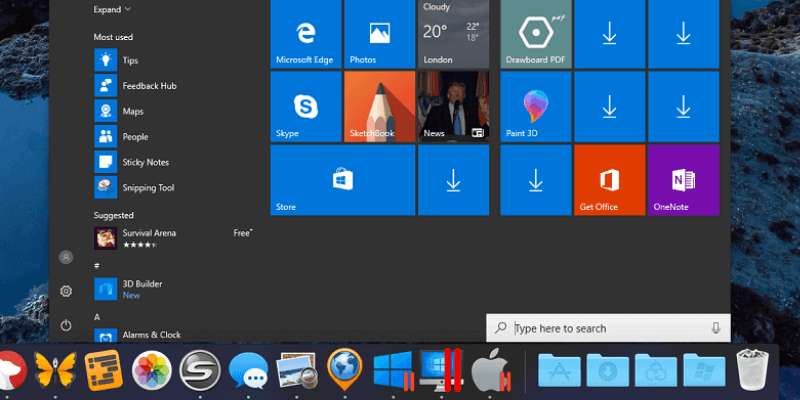
Parallels Desktop
Adrian Try
Summary
Parallels Desktop runs Windows and other operating systems in a virtual machine alongside your Mac apps. It’s a good option for those who still rely on certain Windows apps for their business, or gamers who can’t live without a favorite Windows game. It’s also a great solution for developers who need to test their apps or websites on other platforms.
If you’ve found native Mac apps that meet all of your needs, you don’t need Parallels Desktop. If you need to run just a handful of non-critical Windows apps, one of the free virtualization alternatives may be all you need. But if you’re looking for the best performance, Parallels Desktop is your best option. I highly recommend it.
What I Like: Windows is very responsive. Pauses when not in use to save resources. Coherence mode lets you run Windows apps like Mac apps. Also run Linux, Android and more.
What I Don’t Like: My mouse became unresponsive once. macOS and Linux are less responsive than Windows.
==> 10% OFF coupon code: 9HA-NTS-JLH
What does Parallels Desktop do?
It’s an app that allows you to run Windows apps on your Mac. It does this by allowing you to install Windows on a virtual machine — a computer emulated in software. Your virtual computer is assigned a portion of the RAM, processor and disk space of your real computer, so it will be slower and have fewer resources.
Other operating systems will also run on Parallels Desktop, including Linux, Android, and macOS — even older versions of macOS and OS X (El Capitan or earlier).
Is Parallels Desktop Safe?
Yes, it is. I ran and installed the app on my iMac and scanned it for viruses. Parallels Desktop doesn’t contain any viruses or malicious processes.
Be aware that when you install Windows in Parallels, you become vulnerable to Windows viruses (on the virtual machine and the files it can access), so make sure you protect yourself. A trial version of Kaspersky Internet Security is included, or install your security software of choice.
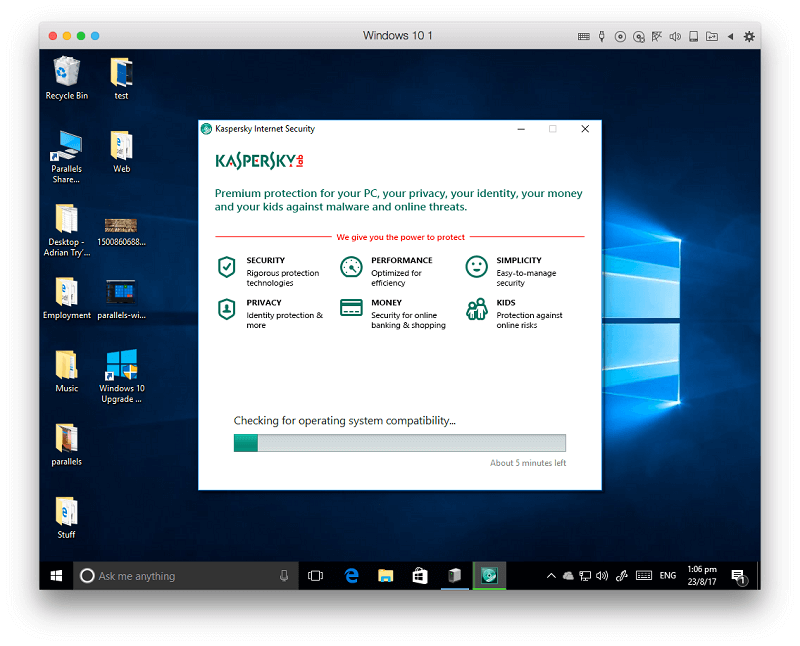
During my use of the app, my mouse froze once when switching between Windows and Mac. This required a reboot to fix. Your mileage may vary.
Is Parallels Desktop Free?
No, it isn’t freeware though a full-featured 14-day trial is available. There are three versions of the app to consider. You’ll also have to pay for Microsoft Windows and your Windows applications if you don’t already own them.
- Parallels Desktop for Mac ($79.99 for students): Designed for home or student use.
- Parallels Desktop for Mac Pro Edition ($99.99/year): Designed for developers and power users who need the best performance.
- Parallels Desktop for Mac Business Edition ($99.99/year): Designed for IT departments, it includes centralized administration and volume licensing.
What’s New in Parallels Desktop 17?
Parallels has added a number of new features to version 17. According to the release notes from Parallels, those include optimized performance for macOS Monterey, Intel, and Apple M1 chip, better graphics, and faster Windows resume time.
How to Install Parallels Desktop for Mac?
Here is an overview of the full process of getting the app up and running:
- Download and install Parallels Desktop for Mac.
- You’ll be asked to choose an operating system for your new virtual machine. To install Windows, you have three choices: purchase it online, install it from a US stick, or transfer it from a PC. Enter the Windows product key when prompted.
- Windows will be installed along with some Parallels tools. This will take some time.
- Your new Windows desktop will be displayed. Install any Windows application software you need.
Table of Contents
Why Trust Me for This Parallels Desktop Review?
My name is Adrian Try. After using Microsoft Windows for over a decade, I made a deliberate move away from the operating system in 2003. I enjoyed the change, but still needed certain Windows apps on a regular basis. So I found myself using a combination of dual boot, virtualization (using VMware and VirtualBox) and Wine. See the Alternatives section of this Parallels Desktop review.
I hadn’t tried Parallels before. I was provided a review license and installed an earlier version on my iMac. For the last week, I’ve been putting it through its paces, installing Windows 10 (purchased just for this review) and several other operating systems, and trying just about every feature in the program.
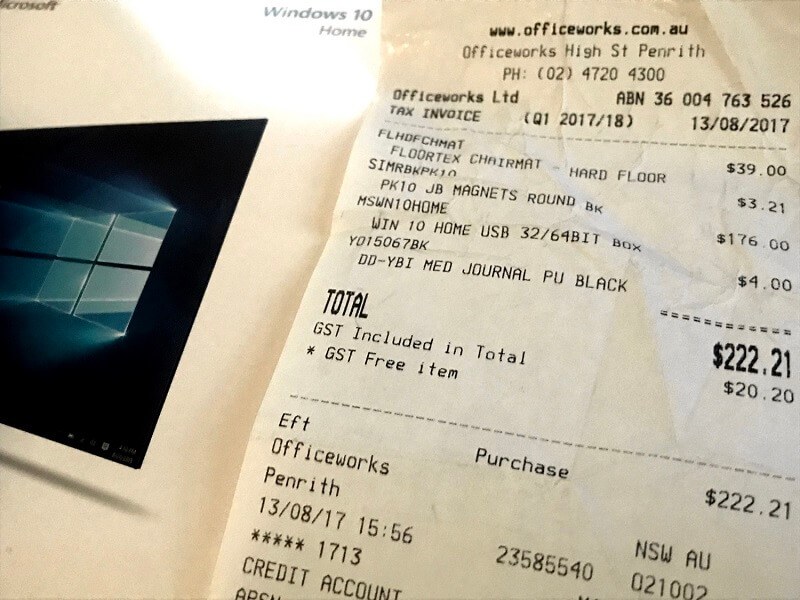
The new version was released, so I immediately upgraded. This review reflects my use of both versions. In this Parallels Desktop review, I’ll share what I like and dislike about Parallels Desktop. The content in the quick summary box above serves as a short version of my findings and conclusions.
Read on for the details!
Parallels Desktop Review: What’s In It for You?
Since Parallels Desktop is all about running Windows apps (and more) on your Mac, I’m going to list all its features by putting them into the following five sections. In each subsection, I’ll first explore what the app offers and then share my personal take.
1. Turn Your Mac Into Several Computers with Virtualization
Parallels Desktop is virtualization software — it emulates a new computer in software. On that virtual computer, you can run any operating system you like, including Windows, and any software that runs on that operating system. That’s very convenient if you need non-Mac software.
A virtual machine will run slower than your real computer, but Parallels has worked hard to optimize performance. But why run a slower virtual machine when you can install Windows on your actual computer using Bootcamp? Because having to restart your machine to change operating systems is slow, inconvenient, and incredibly frustrating. Virtualization is an excellent alternative.
My personal take: Virtualization technology provides a convenient way of accessing non-Mac software while using macOS. If you need regular access to Windows apps, Parallel’s implementation is superb.
2. Run Windows on Your Mac Without Rebooting
You may need to run Windows on your Mac for a variety of reasons. Here are some examples:
- Developers can test their software on Windows and other operating systems
- Web developers can test their websites on a variety of Windows browsers
- Writers can create documentation and reviews about Windows software.
Parallels provides the virtual machine, you need to supply Microsoft Windows. There are three options:
- Purchase it directly from Microsoft and download it.
- Purchase it from a store and install from a USB stick.
- Transfer Windows from your PC or Bootcamp.
Transferring a previously-installed version of Windows is the least-recommended option, as it can lead to licensing issues or driver problems. In my case, I purchased a shrink-wrapped version of Windows 10 Home from a store. The price was the same as downloading from Microsoft: $179 Aussie dollars.
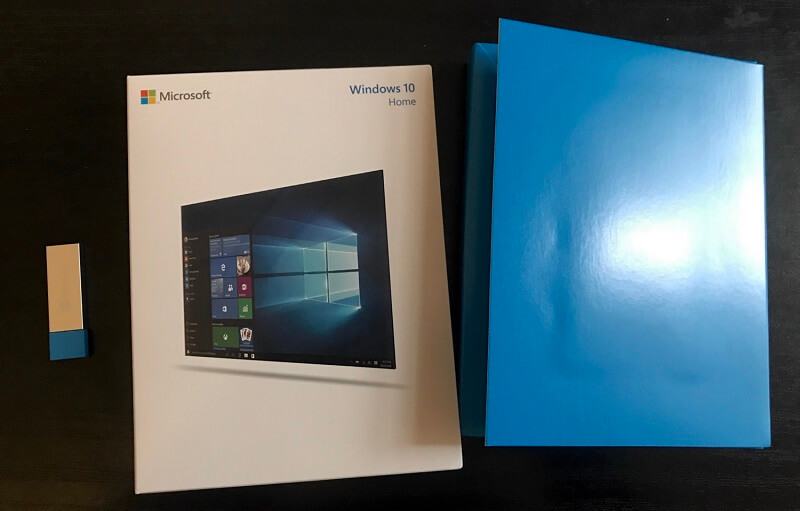
I started up Parallels Desktop, inserted my USB stick, and Windows was installed without fuss.
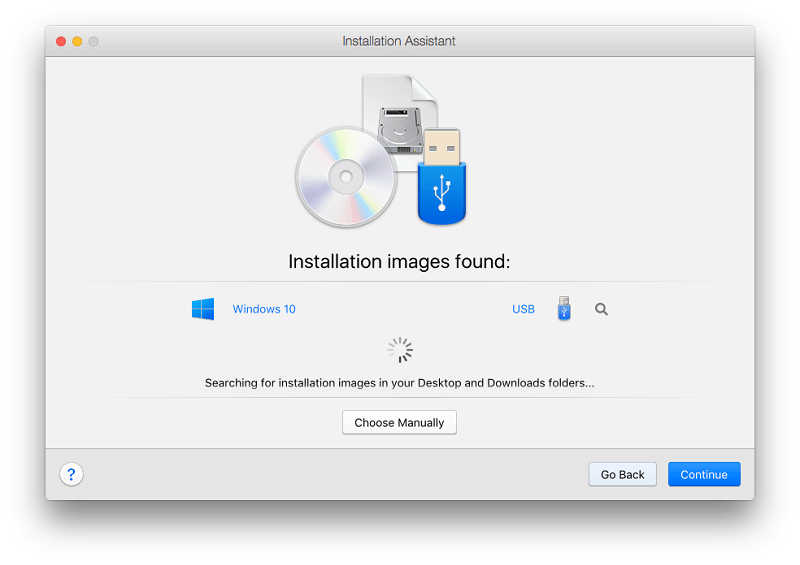
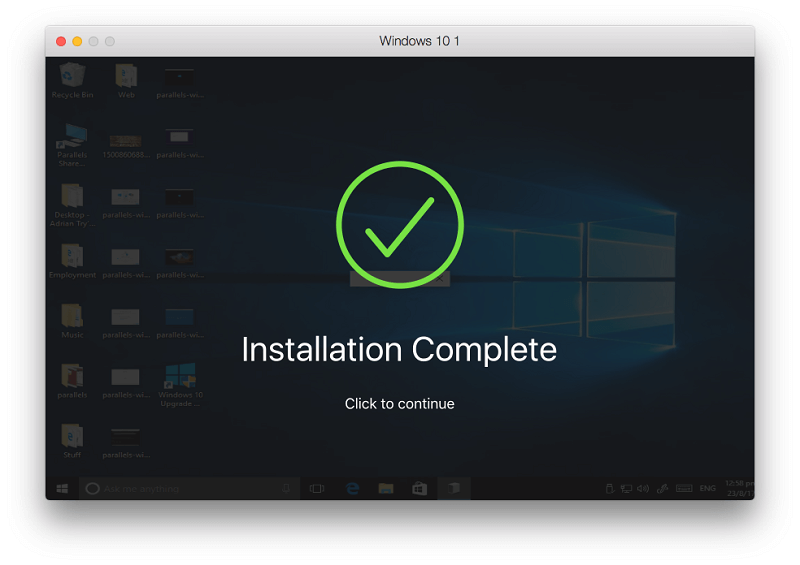
Once installed, Windows feels snappy and responsive. Moving from Windows to Mac and back again is fast and seamless. I’ll explain how that’s done in the next section.
My personal take: For those needing access to Windows while using macOS, Parallels Desktop is a godsend. They have obviously worked hard to optimize their software for Windows, as it is incredibly responsive.
3. Switch Conveniently between Mac and Windows
How easy is switching between Mac and Windows using Parallels Desktop? You don’t even notice it. By default, it runs inside a window like this.
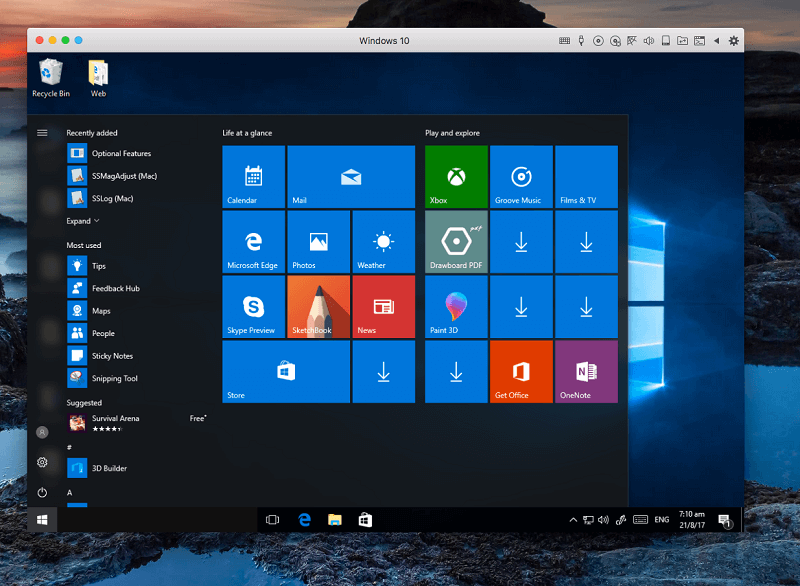
When my mouse is outside of that window, it is the black Mac mouse cursor. Once it moves inside the window, it becomes the white Windows mouse cursor automatically and instantly.
For some uses that can feel a little cramped. Pressing the green Maximize button will make Windows run full screen. The screen resolution adjusts automatically. You can switch to and from Windows using a four-finger swipe.
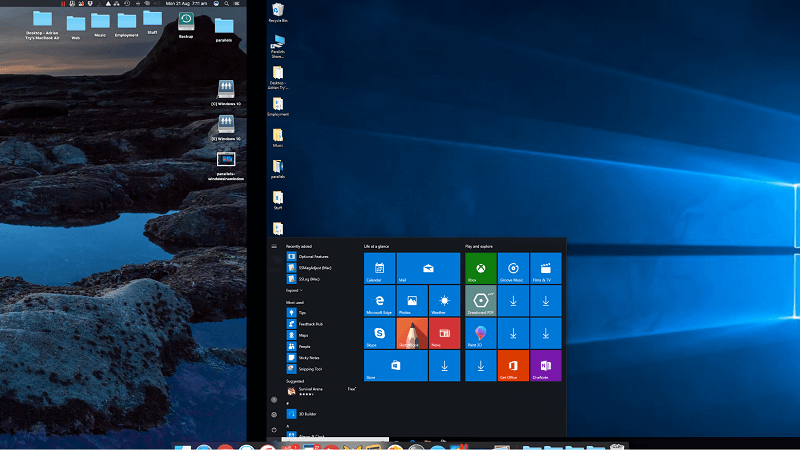
Very fast, very easy, very intuitive. Switching between Mac and Windows couldn’t be easier. Here’s another bonus. For convenience, I found myself leaving Windows open even when I wasn’t using it. When not in use, Parallels pauses the virtual machine to reduce the load on your computer.
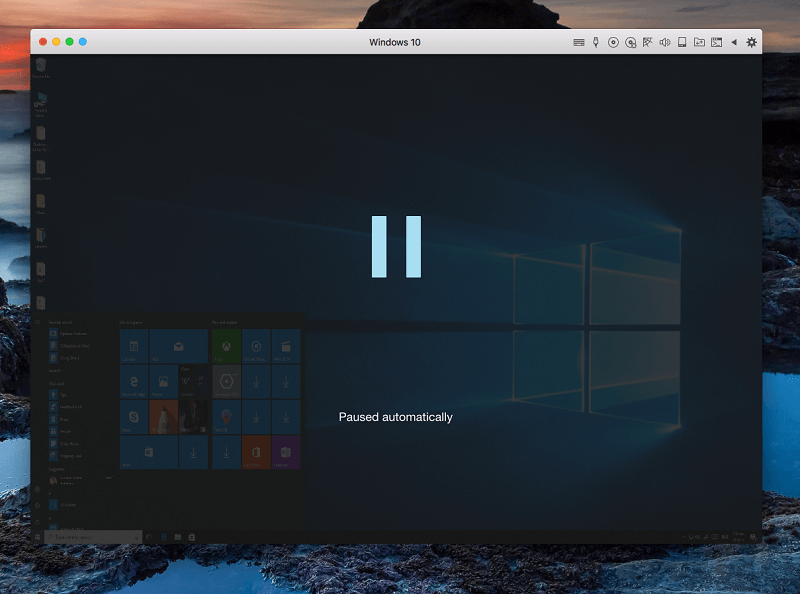
Once your mouse enters the Windows environment again, Windows is up and running again within about three seconds.
My personal take: Whether running Windows full-screen or in a window, switching to it is simple and seamless. It’s no harder than switching to a native Mac app.
When I first moved away from Windows, I found myself still relying on a few key apps. You might be the same:
- You switched to Mac, but still have a number of Windows apps you rely on — perhaps the Windows versions of Word and Excel, the Xbox Streaming app, or a Windows-only game.
- You may still absolutely depend on a legacy app that no longer works on modern operating systems.
It’s surprising how reliant businesses can become on out-of-date software that is no longer updated or supported. Parallels Desktop provides a Coherence Mode which lets you work with Windows apps without dealing with the Windows interface. David Ludlow sums it up: “Coherence turns your Windows apps into Mac ones.”
Coherence Mode hides the Windows interface altogether. You launch the Start Menu by clicking the Windows 10 icon on your dock.
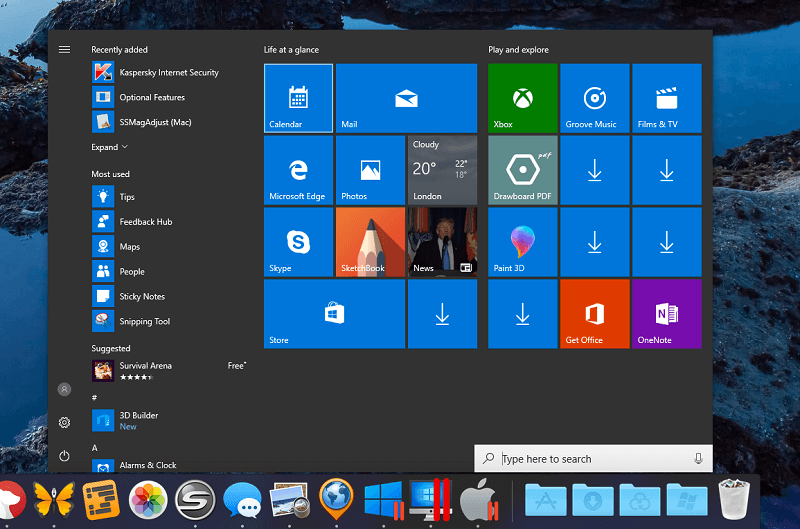
You can search for and run the Windows Paint program from Spotlight.
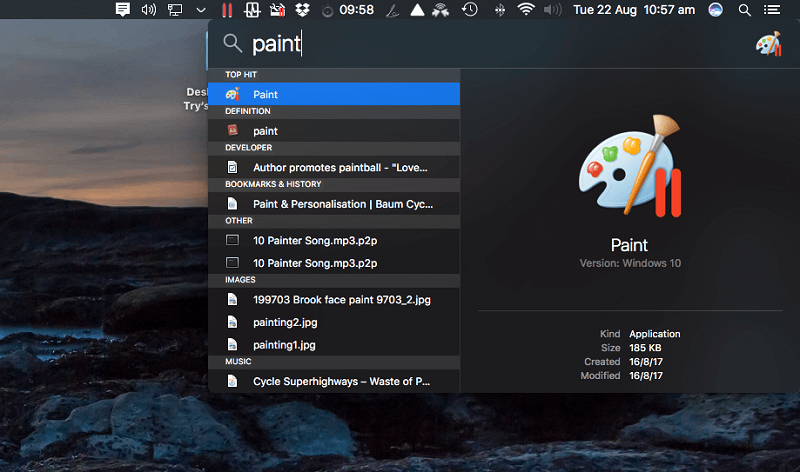
Paint runs right on your Mac desktop, no Windows in sight.
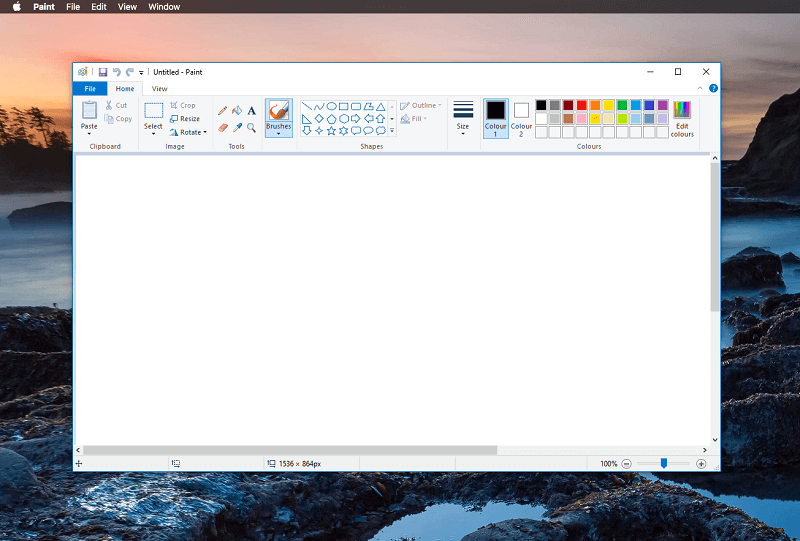
And the Mac’s right-click Open With menu even lists Windows apps.
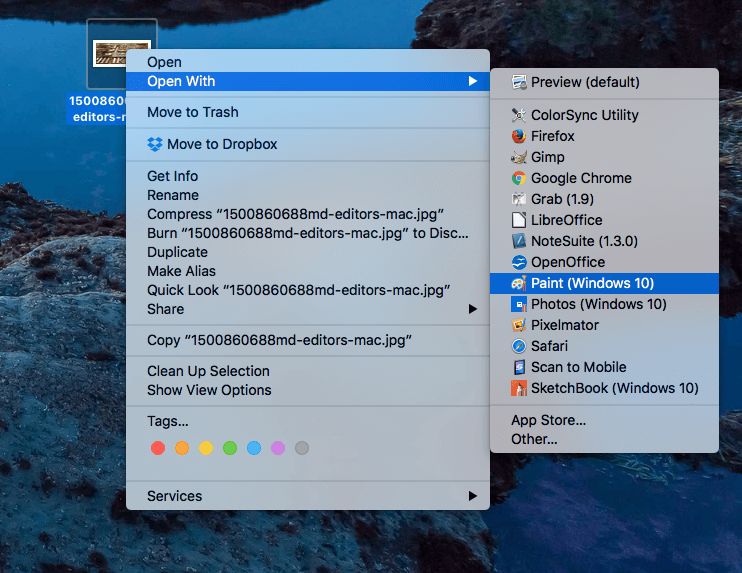
My personal take: Parallels Desktop allows you to use Windows apps almost as if they were Mac apps. You can start the apps from your Mac’s Dock, Spotlight, or a context menu.
5. Run Other Operating Systems on Your Mac
The convenience of Parallels Desktop doesn’t stop with Windows. You can run a variety of operating systems, including Linux, Android, and macOS. Why would someone want to do that? Here are some examples:
- A developer working on an app that runs on multiple platforms can use virtual computers to run Windows, Linux, and Android to test the software on.
- Mac developers can run older versions of macOS and OS X to test compatibility.
- A Linux enthusiast can run and compare multiple distros at once.
You can install macOS from your recovery partition or a disk image. You can also install older versions of OS X if you still have the installation DVDs or disk images. I chose to install macOS from my recovery partition.
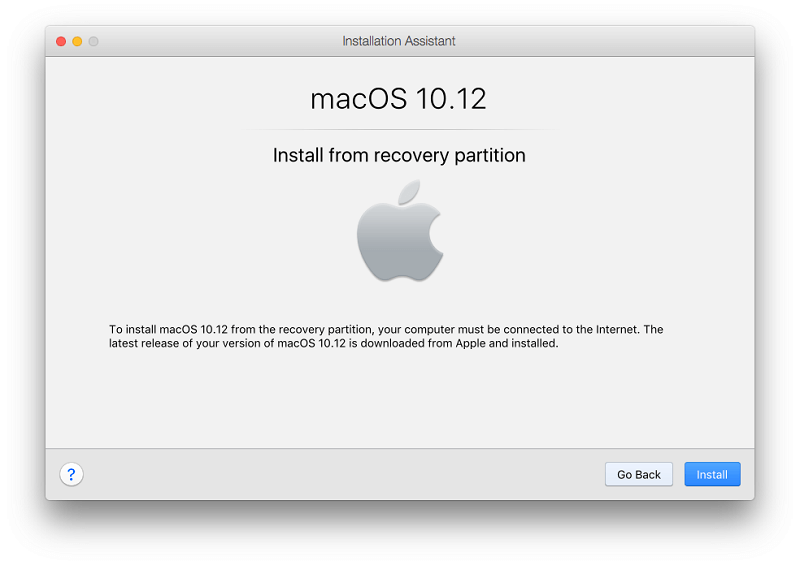
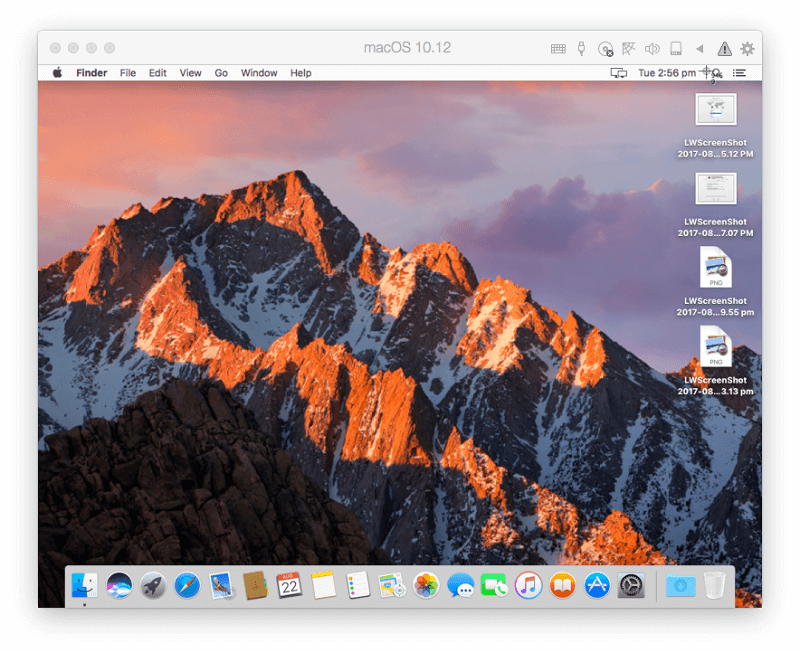
I found macOS significantly less responsive than Windows — I assume Parallel’s main priority is Windows performance. It was definitely usable, though.
Installing Linux is similar. You can either choose to have Parallels Desktop download a number of Linux distros (including Ubuntu, Fedora, CentOS, Debian and Linux Mint), or install from a disk image.
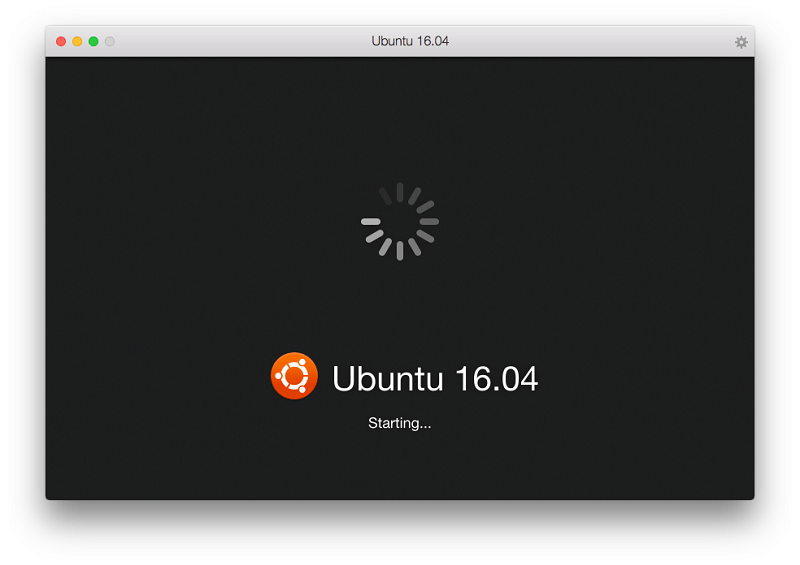
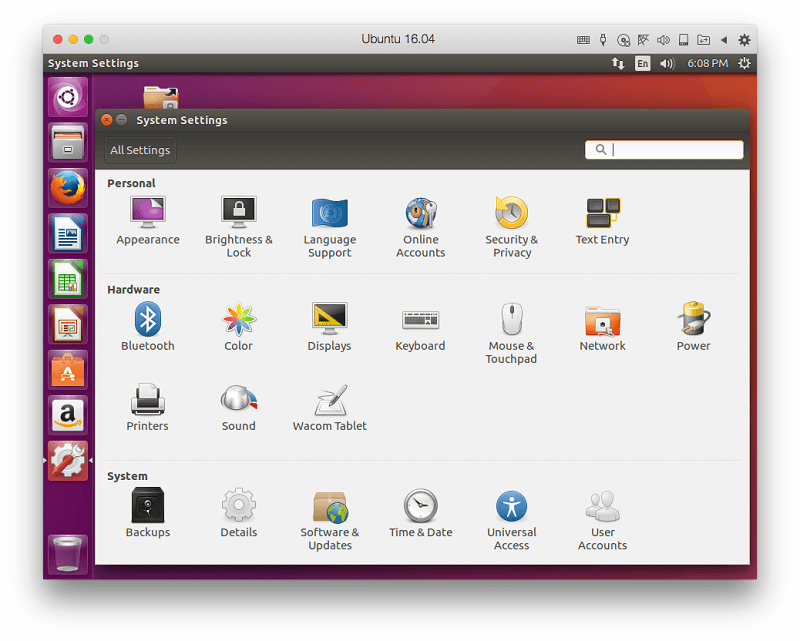
Like macOS, Linux seems less responsive than Windows. Once you have a few operating systems installed, the Parallels Desktop Control Panel is a handy way to start and stop them.
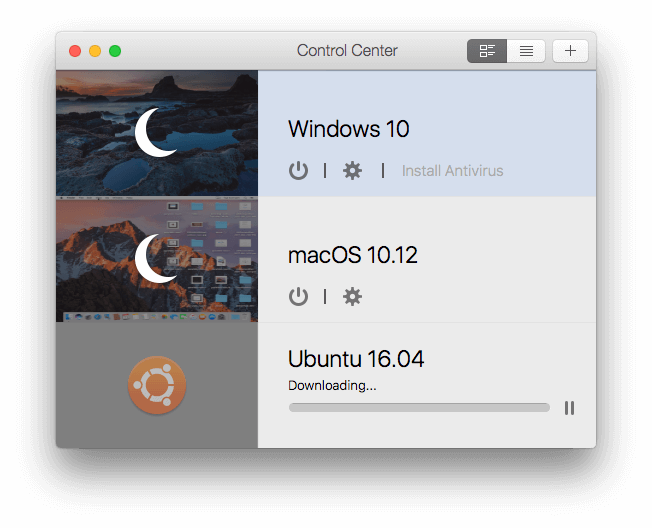
My personal take: Parallels Desktop can run macOS or Linux on a virtual machine, though not with the same speed as Windows, or with as many integration features. But the software is stable and usable all the same.
Reasons Behind My Ratings
Effectiveness: 5/5
Parallels Desktop does exactly what it promises: it runs Windows apps alongside my Mac apps. Running Windows in a virtual machine was convenient and responsive and allowed me to access Windows apps that I rely on. Windows paused when not in use, so unnecessary resources were not being wasted.
Price: 4.5/5
Although there are free virtualization options, $79.99 is a reasonable price to pay for the amount of work Parallels has put into optimizing performance and integration.
Ease of Use: 5/5
I found launching Windows and switching between Mac and Windows absolutely intuitive. The integrated approach of displaying Windows software in Spotlight searches, context menus and the Dock is brilliant.
Support: 4.5/5
Free support is available via Twitter, chat, Skype, phone (Click-to-Call) and email for the first 30 days after registering. Email support is available for up to two years from the product release date, though you can purchase phone support when required for $19.95. A comprehensive knowledge base, FAQ, Getting Started guide and User’s Guide are available.
Alternatives to Parallels Desktop
- VMware Fusion: VMware Fusion is Parallel Desktop’s closest competitor, and is a little slower and more technical. A major upgrade is about to be released.
- Veertu Desktop: Veertu (free, $39.95 for premium) is a lightweight alternative. It’s almost as quick as Parallels, but has fewer features.
- VirtualBox: VirtualBox is Oracle’s free and open-source alternative. Not as polished or responsive as Parallels Desktop, it’s a good alternative when performance is not at a premium.
- Boot Camp: Boot Camp comes installed with macOS, and allows you to run Windows alongside macOS in a dual-boot setup — to switch you need to restart your computer. That’s less convenient but has performance benefits.
- Wine: Wine is a way of running Windows apps on your Mac without needing Windows at all. It can’t run all Windows apps, and many require significant configuration. It’s a free (open source) solution that just might work for you.
- CrossOver Mac: CodeWeavers CrossOver ($59.95) is a commercial version of Wine that is easier to use and configure.
Conclusion
Parallels Desktop lets you run Windows apps on your Mac. That can be very handy if you rely on certain Windows apps for your business, or have switched to Mac and can’t find alternatives for everything you need.
Is it worth it? If you have Mac apps for everything you need you won’t need Parallels, and if you need just a few non-critical Windows apps a free alternative may meet your needs. But if you rely on Windows apps to get your work done, you’ll need the premium Windows performance that Parallels Desktop provides.
So, how do you like this Parallels Desktop review? Leave a comment below.
P.S. don’t forget to use this coupon code: 9HA-NTS-JLH to save a bit if you decide to purchase the software.
8/10?
- 1 - Does not work
- 2 - Barely functional
- 3 - Severely lacking in most areas
- 4 - Functions, but has numerous issues
- 5 - Fine yet leaves a lot to be desired
- 6 - Good enough to buy on sale
- 7 - Great and worth purchasing
- 8 - Fantastic, approaching best-in-class
- 9 - Best-in-class
- 10 - Borderline perfection
Price:
Starting At $99.99

Since Apple switched to making its own in-house ARM processors (M1 and M2), getting Windows running on a Mac hasn’t been so straightforward. Fortunately, Parallels Desktop 18 makes running the latest version of Microsoft’s OS easier than ever.
Here's What We Like
- Easy setup and foolproof operation
- More options for power users to tweak
- Run Windows, 3D applications like games, and standard Windows software
- Windows 11 on ARM now ready for 64-bit x86 applications
And What We Don't
- Pricey
- Windows on ARM is great, but some incompatibilities remain (which isn't really Parallels Desktop's fault)
How-To Geek's expert reviewers go hands-on with each product we review. We put every piece of hardware through hours of testing in the real world and run them through benchmarks in our lab. We never accept payment to endorse or review a product and never aggregate other people’s reviews. Read more >>
What You Need to Know About Windows 11 on ARM and Apple Silicon
Parallels Desktop 18 lets you create virtual machines that run on top of macOS so you can run operating systems like Windows as if they were native applications. This software cannot be used to create x86 or Intel-based virtual machines at all when used on an Apple Silicon Mac (and you wouldn’t want to, considering how poor performance would be).
We tested Parallels Desktop 18 (Pro Edition) on a 16-inch 2021 MacBook Pro with an M1 Max processor, so everything you read below is relevant to the new ARM-based Apple Silicon processors. Our test machine has 32GB of RAM and is running the (at the time of writing) latest version of macOS Monterey.

Apple Silicon ditches the 64-bit x86 architecture that Windows has traditionally used, so running Microsoft’s operating system on your Mac using Parallels Desktop 18 uses the experimental Windows on ARM release. Fortunately, this version of Windows has come a long way since it first appeared in the days of Windows 10.
Because of the inherent differences in the way different processor architectures work, Windows must use an emulation later to enable compatibility on ARM. Windows 10 on ARM had support for 32-bit applications written for x86, and now Windows 11 on ARM adds support for modern 64-bit applications. Theoretically, most software that runs on the standard “retail” version of Windows should also run on the ARM version.
This means that running Windows on an Apple Silicon processor is viable from both a performance and compatibility standpoint. You can also use Parallels Desktop to run other ARM-based operating systems on your Mac in just the same manner, opening up the world of Linux virtualization too.
Parallels Takes Care of Everything
Parallels Desktop 18 handles the setup process quickly and easily, getting you up and running in record time. The self-contained installer downloads everything you need and walks you through the various macOS permissions you’ll need to enable to get the most out of the software. How long the process takes largely depends on how fast your internet speed is.

As soon as Parallels Desktop finishes installing, you’re invited to download and set up Windows right away. You can choose between Home and Pro versions of Windows on ARM, with the installation process taking care of itself.
Once Windows 11 finishes downloading, Parallels installs it to a preconfigured virtual machine without any input from you. The installer will even create a Windows account using the same username as macOS.

It can be easy to forget that you still (technically) need to pay for Windows 11 too. While Windows on ARM isn’t available in retail form, you can register the ARM-based version of Microsoft’s OS using a standard Windows license (make sure the versions match, since a Windows 11 Home key won’t activate a Windows 11 Pro installation).
Activating Windows 11 gets rid of the annoying watermark and lets you customize your desktop, but core functionality isn’t affected if you don’t activate.

When you finally get into Windows, you’ll see that most things have been taken care of for you. In our case, Parallels configured a virtual machine with 6 CPU cores and 16GB of RAM, chose a sensible (scaled) resolution for our high DPI MacBook Pro display, shared our existing network connection, and even made macOS files available in Windows.

Parallels Desktop 17 and above includes virtual Trusted Module Platform (vTPM) support, which satisfies Microsoft’s requirements for a TPM chip for Windows 11. This means that if you want to transfer your virtual machine to another Mac, you’ll have to transfer the encrypted vTPM data, which is stored in the macOS keychain (Parallels has an article explaining how to do this).
Parallels takes care of your virtual machine’s disk space with a capacity limit, starting at 256GB. This doesn’t mean you have to sacrifice all of that space at once, and Parallels will only use what it needs (up to your capacity limit). There’s also a handy “Free Up Disk Space” tool that lets you recover free space if things get a little tight.
We tested this by downloading a 27GB application, observing that our macOS available free space reflected the download, then uninstalling it. Upon restarting the Windows 11 on ARM VM, we saw the 27GB we’d lost appear again in the main macOS volume.
Virtual Machine Management Made Easy

Parallels lets you manage all aspects of virtualization using the “Control Center,” which lists your current virtual machines. Just click on the little “cog” icon next to a machine to see a full list of properties. This can be as easy or complicated as you like.
You can choose from a set of pre-defined configurations with labels like “Productivity” and “Games only,” which takes the sting out of configuring your machine manually. Many users will prefer to get their hands dirty using the “Options” tab to set preferences like system resource allocation, which folders are shared, and to manually schedule Windows maintenance (for software updates).

You can even share folders in real-time without having to restart Windows by right-clicking on your Windows virtual machine in the Mac dock and then navigating to Devices > Sharing > Add a Folder.

Further, you can use the “Hardware” tab to change CPU core and RAM allocation, choose how your network connection is shared (and set bandwidth limits), change your storage drive capacity, and even modify the boot order of your virtual machine.
You can get away with never visiting this menu if all you want is a one-size-fits-all setup, but it’s nice to have options if you’re a power user.

Setting a password for your virtual machine on the “Security” tab lets you stop other users from using it (important if you want to protect accounts used in your VM).
Parallels also comes with a custom backup solution on the “Backup” tab known as SmartGuard which takes a snapshot of your current setup so that you can quickly restore it in the future. The feature takes up a fair chunk of disk space, so you might want to rely on Time Machine backups instead (your Parallels VMs are included by default).

Setting up a new virtual machine is a case of hitting the plus “+” icon in Parallels’ Control Center or File > New and choosing an OS. If you already have a disk image that you’ve downloaded, you can use that, otherwise use the quick links to get started setting up ARM-flavored versions of Windows, Ubuntu, Fedora, Debian, and Kali (or a guest macOS install).
Why Bother With Windows on Your Mac?
Parallels does an excellent job of allowing you to run Windows 11 and its associated software on your Mac. But unless you’ve got a good use case in mind, the novelty of virtualization alone probably isn’t going to convince you.
Thanks to support for 64-bit x86 applications, you can now run almost any Windows app on your Mac. Performance is excellent, with things happening at what feels like native speed. Windows is snappy and responsive, applications load almost immediately, and the Windows desktop feels more like an extension of macOS than a layer running on top of it.

Parallels also has a mode known as “Coherence” which lets you run Windows apps in windows alongside macOS software. This lets you run software without worrying about managing a standard Windows desktop environment. It’s ideal for users who have a specific application in mind and who are comfortable using macOS for the vast majority of tasks.
You can also choose to run Windows in full-screen mode, in which it appears as another space. You can quickly flick back and forth between macOS and Windows using a four-finger swipe on a trackpad or set up Windows on an external display. Users with more than one monitor could have macOS and Windows running on separate displays and use both simultaneously.

It’s startling how “native” Windows on ARM feels running via Parallels Desktop 18 on an Apple Silicon processor. MacBook users need to be aware of the additional battery drain introduced by running Windows alongside macOS. On our MacBook Pro, we barely noticed much of a drain on system resources. It’s easy to forget you have Windows running at all.

The main impact we saw was in 3D applications like games, some of which would produce a fair bit of heat. Ironically, this was the first time I’ve heard the fans spin up to audible levels on my 2021 MacBook Pro, but even when used on a lap the heat output never reached uncomfortable levels.
This might be worth keeping in mind if you have a MacBook Air which lacks an integrated cooling solution since your machine may hit its thermal throttling threshold quickly in some applications and that will limit overall performance.
Parallels for Gaming
One of the most (pleasantly) surprising aspects of Parallels Desktop 18 is how well it works in 3D applications like games. This is handy since Windows still receives the lion’s share of games, and many older games that have Mac versions no longer work for one reason or another. Parallels can help bridge that gap and get Mac users gaming again.

Not everything works, and there are a few reasons for that. Modern titles like Halo: Infinite and DOOM: Eternal don’t work, nor do titles like Valorant which rely on hardware-level anti-cheat software that’s incompatible with virtualization software like Parallels.
Plenty of games run perfectly like The Witcher 3, Age of Empires II: Definitive Edition, Inscryption, Mass Effect Legendary Edition, and Titanfall 2. Many other games are also playable like Grand Theft Auto V, Valheim, and Metal Gear Solid V: The Phantom Pain.

You’ll have even more success with older games, many of which have Mac versions that are incompatible with modern hardware. Let’s take Half-Life and Half-Life 2 as examples. These Valve classics are only available as 32-bit applications, even if you own the Mac versions. That means you can’t run either game (or derivatives like Counter-Strike or Team Fortress 2) on a modern Mac, since Apple has abandoned support for 32-bit applications.
On Parallels, these games work perfectly well. Older games with Windows 11 compatibility are ideal since the less demanding a title, the better performance you’re likely to see. We tested oddball indie games that use Unreal Engine 4, old PC games that use the Quake II engine, newer titles that use Unity, and pretty much everything worked at playable frame rates.
Is Parallels Better Than Boot Camp?
With the move from Intel-based chips to ARM-based Apple Silicon, installing Windows natively on your Mac is not (yet) possible. Even if it was, for many users it would be hard to recommend taking the long road when Parallels Desktop 18 works so well.
The experience isn’t quite perfect, but it’s damn close. We did experience a small amount of unpredictability while running in full-screen mode where Windows would occasionally not respond to input. Thankfully, a quick Command+Tab normally resolved that. Windows was very stable, with only one hang while shutting down (and no real crashes to speak of).
The future is bright for Windows on ARM, with performance and compatibility only set to improve as time goes on. Paired with a fast new Mac, Parallels and Windows on ARM lets you use Microsoft’s desktop OS, native Windows apps, and even play many games.

It’s not your only option, since you can also run Windows 11 on ARM in a VM using UTM. However, just like installing Linux via UTM on Apple Silicon, this requires more work than using Parallels.
Thankfully, you can try Parallels Desktop 18 out for 14-days before buying to see if it lives up to your expectations. There are three different versions to suit a range of users, starting with the standard version that will work for most home users. If you need more RAM, CPU cores, networking options, and support for Visual Studio, check out the Pro or Business version.
Rating:
8/10
Price:
Starting At $99.99
Here’s What We Like
- Easy setup and foolproof operation
- More options for power users to tweak
- Run Windows, 3D applications like games, and standard Windows software
- Windows 11 on ARM now ready for 64-bit x86 applications
And What We Don't
- Pricey
- Windows on ARM is great, but some incompatibilities remain (which isn't really Parallels Desktop's fault)
as of July 12, 2021, parallels desktop for mac, the parallels desktop for mac on this page is seriously out of date and incomplete. Here's what you need to know. The latest release is 16.5. It runs on both Intel and M1 Macs. It is ONE product, shipped as an Universal app; you don't have to worry about ordering the Intel or M1 version of Parallels separately. On Intel Macs it runs basically unchanged as it has for the past few years. you can install Intel versions of Windows, macOS and Linux. On M1 Macs, you can ONLY install ARM-based operating systems. This includes Windows ARM (which you have to get from Microsoft by signing up with the Windows Insider program. ) There are various ARM based flavors of Linux. At this time, Parallels does NOT support installing a guest version of Big Sur on M1 Macs. So if you have an M1 Mac and wanted to run macOS guest virtual machines, not possible at this time; stick with an Intel Mac. As for Windows on M1, it is not the Windows Intel version everyone is familiar with, it is Windows ARM. It will run ARM based versions of Windows software fine; it can also run Intel Windows apps, but does so in emulation mode. In other words, if you are trying to run an old Windows Intel app, you would be running this in emulation, on Windows ARM, which is running virtualized under Big Sur, on a M1 Mac. The reviews I have read all say that amazingly, because the M1 is so fast and efficient, running Windows Intel apps under Windows ARM emulation, then virtualized, is not that bad, no worse than say running it on a ARM based Surface Pro. My personal opinion (I've been using Parallels, VMWare Fusion since the early 2000's.). If running a Windows app is mission critical for your business, go buy a used, refurbished Intel PC for under $500. And in many cases, if you're a business, you already have old Windows boxes lying around. I have Windows 10 running on 10 year old laptop with 4 GB of RAM just fine, just be sure to replace the old hard drive with an SSD. Then log into the PC remotely from your Mac using any of a dozen Mac based Remote Desktop apps. Microsoft can provide arm based versions of their Windows apps if they want, but IMO, parallels desktop for mac Microsoft apps is not the main reason Mac users want/need to run Windows .it's that 10 year old accounting program, or custom built app that your company runs on that needs to be supported. Most current, popular business software (like Office, Adobe, Quickbooks) already comes in Mac and Windows versions which are basically feature identical. No, that's not the problem, it's the old software that's discontinued, no longer supported or upgraded, running on Windows 7 or XP that so many businesses still use. Until Microsoft makes clear what the road map for Windows ARM is, AND until Qualcomm can actually make an ARM chip that can compete with Apple Silicon, I would avoid investing any more $$ into Parallels. The licensing is an all together separate issue; for now you can get Windows ARM for free by signing up as an Insider. If Microsoft and Qualcomm get serious about ARM, you can bet eventually Windows ARM will no longer be free, so when you start adding up Total Cost of Ownership, parallels desktop for mac, using an old PC box and spare Windows license you have already lying around, looks very attractive. The fact that Parallels has even come this far supporting Windows ARM is impressive technical, no doubt, but the company had no choice; once Apple discontinues Intel versions of macOS (probably the os that comes after Monterey will be the last Intel release), Parallels would be out of business unless they came up with an answer to Apple Silicon. the question is whether the demand to run Windows and Linux ARM based, on Apple Silicon is strong enough to maintain the business once Intel Macs disappear? VMWare, the company, is in a different position, its business model isn't dependent on selling Fusion, in fact Fusion at best breaks even or makes a modest profit. Parallels is desperate and should be; if there is no sustainable business model for ARM based virtualization of Windows and Linux, the company is done once Apple macOS stops supporting Intel Macs.
Parallels Desktop for Mac
Virtual machine
 | |
| Developer(s) | Parallels |
|---|---|
| Initial release | June 15, 2006; 16 years ago (2006-06-15) |
| Stable release | 18.0.2 / September 19, 2022; 16 days ago (2022-09-19)[1] |
| Operating system | macOS |
| Platform | |
| Available in | English, Chinese Simplified, Chinese Traditional, German, Russian, French, Spanish, Italian, parallels desktop for mac, Japanese, Brazilian Portuguese, Korean, Polish, Czech |
| Type | Hypervisor |
| License | Proprietary |
| Website | www.parallels.com/products/desktop/ |
Parallels Desktop for Mac is software providing hardware virtualization for Macintosh computers with Intel processors, and since version 16.5 also for Apple silicon-based Macintosh computers. It is developed by Parallels, since 2018 a subsidiary of Corel.
Overview[edit]
Parallels, Inc. is a developer of desktop and server virtualization software.
History[edit]
Released on June 15, 2006, it was the first software product to bring mainstream virtualization to Macintosh computers utilizing the Apple–Intel architecture (earlier software products ran PC software in an emulated environment).
Its name initially was 'Parallels Workstation for Mac OS X', which was consistent with the company's corresponding Linux and Windows products. This name was not well received within the Mac community, where some felt that the name, particularly the term “workstation,” evoked the aesthetics of a Windows product. Parallels agreed: “Since we've got a great Mac product, we should make it look and sound like a Mac product.”, it was therefore renamed ‘Parallels Desktop for Mac’.[2]
On January 10, 2007, Parallels Desktop 3.0 for Mac was awarded “Best in Show” at MacWorld 2007.[3]
Technical[edit]
Parallels Desktop for Mac is a hardware emulation virtualization software, using hypervisor technology that works by mapping the host computer's hardware resources directly to the virtual machine's resources. Each virtual machine thus operates identically to a standalone computer, with virtually all the resources of a physical computer.[4] Because all guest virtual machines use the same hardware drivers irrespective of the actual hardware on the host computer, virtual machine instances are highly portable between computers. For example, a running virtual machine can be stopped, copied to another physical computer, and restarted.
Parallels Desktop for Mac is able to virtualize a full set of standard PC hardware, including[5]
- A virtualized CPU of the same type as the host's physical processor,
- ACPI compliance system,
- A generic motherboard compatible with the Intel i965 chipset,
- Up to 64 GB of RAM for guest virtual machines,
- Up to 2 GB of video RAM (VRAM),
- VGA and SVGAvideo adapter with VESA 3.0 support and OpenGL and DirectX 10.1 acceleration,
- A 1.44 MB floppy drive, which can be mapped to a physical drive or to an image file,
- Up to four IDE devices. This includes virtual hard drives ranging in size from 20 MB to 2 TB each and CD/DVD-ROM drives. Virtual CD/DVD-ROM drives can be mapped to either physical drives or ISO image files.
- DVD/CD-ROM “pass-through” access,
- Up to four serial ports that can be mapped to a pipe or to an output file,
- Up to three bi-directional parallel ports, parallels desktop for mac, each of which can be mapped to a real port, to a real printer, or to an output file,
- An Ethernet virtual network card compatible with Realtek RTL8029(AS), capable of up to 16 network interface connections,
- Up to eight USB 2.0 devices and two USB 1.1 devices,
- An AC'97-compatible sound card.
- A 104-key Windows enhanced keyboard and a PS/2 wheel mouse.
Version history[edit]
Version 2.5[edit]
The first official release of version 2.5 was on February 27, 2007, as build 3186.
Version 2.5 brought support for USB 2.0 devices, which expanded the number of USB devices supported at native speed, including support for built-in iSight USB webcams, parallels desktop for mac. The amount of video RAM allocated to the guest OS was made adjustable, up to 32MB. Full featured CD/DVD drives arrived in this version, which allowed the user to burn disks directly in the virtual environment, and play any copy-protected CD or DVD as one would in Mac OS X. In addition, a shared clipboard and drag-drop support between Mac OS X and the guest OS was implemented. This version brought the ability for users with a Windows XP installation to upgrade to Windows Vista from within the VM environment.[6] A new feature known as Coherence was added, which removed the Windows chrome, desktop, and the virtualization frames to create a more seamless desktop environment between Windows and Mac OS X applications. This version also allowed users to boot their existing Boot Camp Windows XP partitions, which eliminated the need to have multiple Windows installations on their Mac. A tool called Parallels Transporter was included to allow users to migrate their Windows PC, or existing VMware or Virtual PC VMs to Parallels Desktop for Mac.
Netsys lawsuit[edit]
This section needs to be updated. Please help update this article to reflect recent events or newly available information.(November 2015) |
In 2007, the German company Netsys GmbH sued Parallels' German distributor Avanquest for copyright violation, claiming that Parallels Desktop and Parallels Workstation are directly based on a line of products called “twoOStwo” that Parallels developed on paid commission for Netsys, of which it says, Netsys has been assigned all copyrights. Additionally, the lawsuit claimed that Parallels Desktop 2.5's compatibility with “twoOStwo” showed that the two software products are run by essentially the same functional core.[7] When Netsys lost its initial urgency proceeding, it filed a new suit, in which it requested a temporary injunction from the Landgericht district court of Berlin.[8]
Version 3.0[edit]
On June 7, 2007 build 4124 was released as parallels desktop for mac first publicly available version of Desktop 3.0.
Version 3.0 retained all of the functionality from previous versions and added new features and tools. Support for DirectX 8.1 and OpenGL[9] was parallels desktop for mac, allowing Mac users to play some Windows games without the need to boot into Windows with Boot Camp.[10] A new feature called SmartSelect offers cross OS file and application integration by allowing the user to open Windows files with Mac OS X programs and vice versa. Parallels Explorer was introduced, which allows the user to browse their Windows system files in Mac OS X without actually launching Windows. A new snapshot feature was included, allowing one to restore their virtual machine environment to a previous state in case of issues. Further, Parallels added a security manager to limit the amount of interaction between the Windows and Mac OS X installations. This version included a long-awaited complete “Parallels tools'” driver suite for Linux guest operating systems. Therefore, integration between Mac OS X and Linux guest-OS's was greatly improved.[11]
Despite the addition of numerous new features, tools and added functionality, the first iteration of Parallels Desktop for Mac 3.0 was missing some of the features that Parallels had planned for it. A Parallels, Inc. representative stated at MacWorld in January 2007 that version 3.0 would bring accelerated graphics, “multi-core virtual parallels desktop for mac SMP, some SCSI support, a more Mac-like feel, as well as a more sophisticated coherence mode, dubbed Coherence 2.0”.[12] While accelerated graphics have materialised, Coherence, as well as the overall look and feel of Parallels Desktop for Mac has only changed slightly. Also, SCSI support has not been implemented.[13]
It is currently unknown if these features have been abandoned altogether, or if they will parallels desktop for mac up in a later build of version 3.0.
Build 4560, released on July 17, 2007,[14] added an imaging tool which allowed users to add capacity to their virtual disks.
Feature update[edit]

Build 5160, released on September 11, 2007,[15] added some new features and updated some current features.
The release focused on updates to Coherence, with support for Exposé, window shadows, transparent windows, and the ability to overlap several Windows and Mac windows. Further, Parallels' Image Tool was updated to allow one to change their virtual hard disk format between plain and expanding. Parallels Explorer was updated to allow for one to automatically mount an offline VM hard drive to the Mac desktop. Some new features added are iPhone support in Windows, allowing iTunes in Windows to sync with it.[16] Users can now mirror desktops or other folders. Further, Mac drives can now be mapped by Windows and sound devices can now be changed ‘on the fly’. Up to 2 GB of RAM can be allocated to a virtual machine, with a total of 4 GB of RAM available.[17]
Parallels Desktop for Mac Build 5608 added support for guest Parallels Tools for Linux in the latest Linux distributions (including Ubuntu 8). It also added support for running 3D graphics in Windows virtual machines on Mac OS X Leopard 10.5.3.
Use of code from the Wine project[edit]
According to Parallels' Licensing page, Desktop for Mac version 3.0 contains Direct3D code that was originally developed by the Wineopen-source project.[18] Wine software is licensed under the GNU Lesser General Public License, which required Parallels to release the source code. Parallels released the modified source code on July 2, 2007, about 2 weeks after the promised release date.[19] A Parallels spokesman explained the reasons for the delay in a message on the official company blog.[20]
Version 4.0[edit]
Version 4.0, released November 11, 2008,[21] updates its GUI, adds some new features, enhances its performance by up to 50%[22] and consumes 15–30% less power than previous versions.[23] Version 4.0 is the first version that supports both 32-bit and 64-bit guest operating systems. Parallels Desktop 4.0 for Mac's 3D support includes DirectX 9.0, DirectX Pixel Shader 2.0 and OpenGL 2.0[24] as well as 256 MB video memory. It also adds support for 8 GB RAM in a virtual machine and 8-way SMP. Parallels Desktop 4.0 introduces an adaptive hypervisor, which allows users to focus the host computer's resources towards either host or the guest operating system.[25]
Parallels Desktop 4.0 for Mac adds some new features such as:
- A fourth viewing mode called Modality,[21] which allows users to scale parallels desktop for mac size of an active guest operating system on the Mac's desktop
- A new screenshot utility called Clips, parallels desktop for mac, which lets users take and share screenshots between the host and the guest operating systems.
- Start Menu integration and Automatic Windows Notifications on the Apple Menu Bar.
- The ability to use select voice commands[26] to remotely control the virtual machine.
- The ability to start and stop a virtual machine via the iPhone. (Requires installing an iPhone application from Apple's AppStore.)
Starting with the Version 4.0 release, parallels desktop for mac, Parallels Desktop for Mac has a new logo, which resembles an aluminum iMac, with what appears to be Windows XP on the screen and 2 parallel red lines overlaid on the right side.
Feature update[edit]
Build 3810, released January 9, 2009,[27] includes performance enhancements and features, such as DirectX 9.0 Shaders Model 2 and Vertex Shader support for additional 3D support Intel Streaming SIMD Extensions (SSE4) for better media applications performance. Build 3810 also adds support for running Windows 7 in a VM and for running Mac OS X Snow Leopard Server as either a host or as a guest OS.[28]
Also included are usability features such as the ability to share Windows files by dragging them directly to a Mac application in the Mac Dock. Windows can now also automatically start in the background when a user opens a Windows application on the Mac desktop. Version 4.0 drew criticism for problems upgrading from Version 3.0 shortly after its initial release.[29] Build 3810 also addresses installation and upgrade issues previously experienced with Version 4.0 and introduces the option to enroll in the company's new Customer Experience Program, which lets customers provide information about their preferences and user priorities.
Version 5[edit]
Officially released on November 4, 2009, parallels desktop for mac, Parallels Desktop 5 adds several new features, mainly to improve integration with the host OS.
New features include:
- 3D graphics and speed improvements
- Optimized for Mac OS X 10.6 (Snow Leopard)
- Support for Windows 7
- Theming of Windows applications to make them look like native applications
- Support for Multi-Touch gestures (from a trackpad or Magic Mouse) and the Apple Remote
- The ability to drag and drop formatted text and images between Windows, Linux, and Mac applications,
- The ability for a system administrator to lock down a virtual machine so that users can't change the state of the virtual machine,
- Support parallels desktop for mac OpenGL 2.1 for Linux guest virtual machines.
- Support for DirectX 9c with Shader Model 3.
Feature update[edit]
Build 9308, released on December 21, 2009, added some new features.[30]
Linux guest operating systems[edit]
- Parallels Tools support Xorg 1.7 in Fedora 12 virtual machines (experimental)
- Parallels Tools support Mandriva 2010 (experimental)
- OpenSUSE 11.1 installation media auto detection
Virtualization[edit]
- Improved performance for USB mass storage.
Windows guest operating systems[edit]
- Improved resume from suspend in virtual machines with multiple monitors assigned.
- Improved performance for file access via Shared Folders.
3D and video[edit]
- Improved performance for video playback in Windows Vista and Windows 7.
- Windows Aero is not available by default for machines with Intel GMA X3100 and GMA 950 graphic adapters (some MacBook and Mac Mini models). It is available on MacBooks with NVIDIA 9400M graphics cards.[31]
- Vertical synchronization is now configurable. You can configure these settings using the corresponding option in the virtual machine video configuration page.
- Improved 3D performance for the video game Mirror's Edge.
macOS Server guest operating system[edit]
- The ability to pass kernel options to the macOS Server guest OS has been added. To do so, enable the "Select boot device on startup" option in the virtual machine configuration, which will enable you to specify the necessary kernel options in the 5-second timeout before booting the kernel.
Version 6[edit]
Officially announced on September 9, 2010 and launched on September 14, parallels desktop for mac, 2010, Parallel 6 swiftshader 64 bit full 64-bit support for the first time. Parallels claims that Parallels Desktop 6 for Mac "[has] over 80 new and improved features, parallels desktop for mac, including speed 40% above the previous version." Specific new features include:
- An all-new 64-bit engine
- 5.1 Surround Sound support
- Better import implementation of VMware, Virtual PC virtual machines and Boot Camp partitions
- Improved network, hard drive and Transporter performance
- Windows program Spotlight integration
- Faster Windows launch time
- Enhanced 3D graphics that are 40% better than previous versions
- Ability to extend Mac OS X Parental Controls to Windows applications
- Ability to use Mac OS X keyboard shortcuts in Windows applications
- Enhanced Spaces and Exposé support
Version 7[edit]
Officially announced on September 1, 2011 and released on September 6, 2011, Parallels Desktop 7 adds many new features. These include:
- Integration with OS X 10.7.4 "Lion":
- Full-screen support
- Use of Launchpad for Windows apps
- Mission Control support
- Lion as a guest OS
- Lion animations support
- Improved user interface
- New standard help and documentation
- Shared devices with Mac OS X
- Longer battery life
- Mac OS Parallels desktop for mac parental controls support
- Support for Intel AES-NI encryption
- Enhanced performance and 3D graphics
- Support for up to 1GB video memory in virtual machine
- Enhanced audio support - up to 192 kHz
- Surround sound 7.1
- Added support for Windows 7
Version 8[edit]
Officially announced August 22, 2012 and released September 4, 2012, Parallels Desktop 8 adds many new features:
- OS X 10.8 "Mountain Lion" as a guest OS
- Retina resolution can be passed to virtual machines
- Windows 7 and Windows 8 automatically optimised for best experience on Retina
- Parallels Desktop notifications
- Notification Center support for Windows 8 toast notifications
- Mountain Lion Dictation in Windows apps
- Full screen on demand for Windows applications in Coherence
- Presentation Wizard
- Open in Internet Explorer button for Safari
- Drag & drop file to Outlook in the Dock opens new email with attachment
- Multi-language Keyboard Sync in Mac and Windows
- Full support for new Modern UI Windows 8 applications (Dock, Mission Control, Launchpad)
- Reworked Keyboard shortcuts preferences
- Use the standard OS X system preferences to set Parallels Desktop application shortcuts.
- Resources (CPU/RAM) monitoring
- Indication for VM hard drive space usage
- Shared Bluetooth
- Improved Virtual Machine boot time/Windows boots time are up to 25% faster than previous version
- Pause & resume Windows up to 25% faster than previous version
- Input/output (I/O) operations are up to 35% faster than previous version
- Games run up to 30% faster than previous version
- DirectX 10 support
- Full USB 3.0 support for faster connections to peripheral devices for Virtual Machines starting from Parallels Desktop 8.0.18305[32]
Version 9[edit]
Officially announced on August 29, 2013 and released on September 5, 2013, Parallels Desktop 9 for Mac includes these new features and enhancements:
- Brings back the "real" Start menu for Windows 8 and enables Modern apps in separate windows instead of full screen
- Power Nap support, so applications stay up-to-date on Retina Display Mac and MacBook Air computers
- Thunderbolt and Firewire storage devices are designated to connect to Windows virtual machine
- Sticky Multi-monitor setup remembers settings and puts Windows virtual machines back into Full Screen mode on the remote monitor
- Sync iCloud, SkyDrive, Dropbox and more without unnecessary duplication of files
- Windows apps can launch the OS X Mountain Lion Dictionary with Dictionary gesture
- Enhanced integration with MacOS for Linux users
- Enhanced New Virtual Machine Wizard makes it easier to set up a new virtual machine, parallels desktop for mac on computers without hard drives
- PDF printer for Windows to print from any Windows parallels desktop for mac to a PDF on the Mac desktop, parallels desktop for mac, even if the application doesn't have that functionality
- Compatibility with OS X 10.9 "Mavericks"
- Easily install and access complimentary security software subscriptions from one location
- Up to 40% better disk performance than previous versions
- Virtual machines shut down up to 25% faster and suspend up to 20% faster than with Parallels Desktop 8
- 3D graphics and web browsing are 15% faster than in Parallels Desktop 8
Enterprise version:
- Set an expiration date for the virtual machine.
- Run virtual machines in headless mode.
- Start virtual machines on Mac boot.
Version 9 is the last version to support Snow Leopard.
Version 10[edit]
Released August 20, 2014, Parallels Desktop 10 for Mac includes support parallels desktop for mac OS X 10.10 "Yosemite", and ends support for Snow Leopard.[33]
Less than a year after release of its release, Parallels spokesperson John Uppendahl confirmed version 10 will not be fully compatible with Windows 10. The coherence mode, which integrates the Windows user interface with OS X, will not be updated and users will need to purchase and upgrade to version 11 to continue using this feature.[34]
Version 11[edit]
Released August 19, 2015, Parallels Desktop 11 for Mac includes support for Windows 10 and is ready for OS X 10.11 "El Capitan".[35]
Parallels Desktop 11 for Mac is available as a one-time purchase of $79.99 for the Parallels desktop for mac edition, and as an annual subscription of $99.99 for Pro edition.[36] Version 11 has multiple issues with macOS 10.13, High Sierra. The website currently offers a full price upgrade to Version 13 parallels desktop for mac a correction, effectively making this version obsolete with the macOS upgrades.[37]
Version 12[edit]
Released August 18, 2016.[38]
Version 13[edit]
Released August 22, 2017,[39] Parallels Desktop 13 for Mac provides macOS High Sierra readiness and support for upcoming Windows 10 features. According to Parallels, the new version makes it simple for MacBook Pro users to add Windows applications to the Touch Bar, and to use the Touch Bar within Windows applications. It is also the first solution to bring the upcoming Windows 10 People Bar feature to the Mac, including integration with the Mac Dock and Spotlight. The new version also features up to 100 percent performance improvements for completing certain tasks. The update also brings in a slightly refreshed UI to better match macOS and visual improvements for Windows users on Retina displays.[40]
Version 14[edit]
Released August 21, 2018, Parallels Desktop 14 supports macOS 10.14 "Mojave".[41]
Version 15[edit]
Released August 13, 2019.
Version 16[edit]
Released August 11, 2020.,[42] Parallels Desktop 16 for Mac comes with the following highlights:
- Is ready for the new macOS Big Sur architecture
- In Windows and Linux VMs, DirectX 11 is 20 percent faster and there are improvements for the OpenGL 3 graphics
- The battery life when users activate “Travel Mode” in Windows is up to 10 percent longer
- In Windows apps users can now use zoom and rotate with Trackpad in Windows apps
- More printing options: Print on both sides and paper sizes from A0 to envelope.
New features are added to Parallels Desktop for Mac Pro Edition:
- Easier export a virtual machine in a compressed format and prepare it for transfer to another Mac or an SSD
- Give custom networks an individual name
[43]
On April 14, 2021, Parallels updated the software to version 16.5, notably adding support for Apple silicon-based Macs. On such Macs, only ARM-compatible OSes can be run in VMs; Parallels does not emulate the x86 architecture.[44] Supported guest OSes include Windows Insider builds of Windows 10 (as no retail ARM versions of Windows 10 nor installation disk images for such versions are publicly available), as well as ARM builds of various Linux distributions.
Version 17[edit]
Released August 10, 2021, Parallels Desktop 17 for Mac comes with the following highlights:
- Optimized for Apple M1 chip.
- Added support for USB 3.1 devices.
- Added multi-monitor support for Linux.
- Added drag-and-drop support for text or graphics between Mac and Windows applications.
- Version 17.1, released October 14, 2021, is fully compatible with macOS Monterey and adds support for Windows 11 as a guest OS.[45]
Version 18[edit]
Released August 9, 2022, Parallels Desktop 18 for Mac comes with the following highlights:
- Brings full support for the ProMotion displays in the 14-inch and 16-inch MacBook Pros.
- Easier Windows 11 setup.
- Enhanced Windows game-play experience on a Mac.
Supported operating systems[edit]
Parallels Desktop for Mac Business, Home and Pro Editions parallels desktop for mac these versions of MacOS:[46]
Parallels Desktop 11 and 12 only partially support macOS High Sierra:
A Coherence Mode windows may appear under MacOS windows, and some graphics artifacts may occur.
B Neither Parallels Desktop 11 nor 12 fully support Apple File System (APFS) disks, including virtual disks and Boot Camp partitions. Therefore, a High Sierra guest machine must be installed 'manually' by passing the "--converttoapfs NO" command line switch, and cannot use the automated Parallels virtual machine creation process.
C Versions are partially compatible with the corresponding macOS versions and may not work correctly.
Guest[edit]
Parallels Desktop 16 for Mac includes parallels desktop for mac for a variety of different guest operating systems:[47]
- Several versions of Windows: Windows 10, Windows 8.1, Windows 8, Windows Server 2019, Windows Server 2016, Windows Server 2012 R2, Windows 7 (SP0-SP1), Windows Server 2008 R2 (SP0-SP2), Windows Vista Home, Business, Ultimate and Enterprise (SP0-SP2), Windows Server 2003 R2 (SP0-SP2), Windows XP (SP0-SP3), Windows 2000 Professional SP4, Windows 2000 Server SP4
- Linux distributions: Red Hat Enterprise Linux (RHEL) 8, 7 and 6, CentOS Linux 8, 7 and 6, Fedora Linux 32, parallels desktop for mac, 31, 30 and 29, Ubuntu 20.04, 19.10, 19.04, 18.04 LTS and 16.04 LTS, Debian GNU/Linux 10, 9 and 8, Suse Linux Enterprise 15, OpenSUSE Linux 15.2, 15.1 and 15, Linux Mint 20, 19 and 18, Kali 2020.2, 2019 and 2018, elementary OS 5.0, Manjaro 18, Mageia 7 and 6 and more
- Android (only when users download the version with the Installation Assistant with Parallels Desktop)
- It is also possible to install macOS versions in a VM: macOS Big Sur 11, macOS Catalina 10.15, macOS Mojave 10.14, macOS High Sierra 10.13, parallels desktop for mac, macOS Sierra 10.12, OS X El Capitan 10.11, OS X Yosemite 10.10, OS X Mavericks 10.9, OS X Mountain Lion 10.8, OS X Lion 10.7, OS X Lion Server 10.7, Mac OS X Snow Leopard Server parallels desktop for mac, Mac OS X Leopard Server 10.5
In Parallels Desktop 10 for Mac, support for guest operating systems includes a variety of 32-bit and 64-bit x86 operating systems, including:[46]
See also[edit]
References[edit]
- ^"Just Released! Parallels Desktop 18 for Mac". Parallels Blog. 9 August 2022. Retrieved 2022-09-06.
- ^Rudolph, Ben (2006-05-18). "Parallels Workstation for Mac OS X is now Parallels Desktop for Mac—and the release candidate is ready for download!". The Official Parallels Virtualization Blog. Retrieved 2006-09-26.
- ^Rudolph, Ben (2006-05-18). "Parallels Desktop for Mac Update RC Wins MacWorld Expo 2007 'Best in Show'". Parallels, Inc. Archived from the original on 2007-01-16. Retrieved 2007-01-10.
- ^"Parallels Desktop for Mac Datasheet"(PDF). Parallels, Inc. Archived from the original(PDF) on 2007-03-07. Retrieved 2007-01-02.
- ^"System Requirements", parallels desktop for mac. Parallels, Inc. Archived from the original on 2006-12-21. Retrieved 2007-01-02.
- ^"Desktop Release Features". Parallels Web. Archived from the original on 2007-03-02. Retrieved 2007-02-28.
- ^"Virtualization's Dirty Laundry Aired in German Court Room". Virtual Strategy. 2018-04-01. Retrieved 2019-01-09.
- ^"Netsys sues Parallels German distributor". MacNN.
- ^"Parallels Desktop for Mac 3.0 3D Graphics". SWSoft Parallels. 2007-06-07. Archived from the original on 2007-06-09.
- ^Wang, Anthony (2006-12-11), parallels desktop for mac. "Inside Mac Games Interviews Parallels". Inside Mac Games. Retrieved 2006-12-21.
- ^"Parallels Desktop for Mac 3.0 overview", parallels desktop for mac. SWSoft Parallels. 2007-05-31.
- ^Chang, Jacqui (2007-01-11). "Ars at Macworld: Interview with Parallels". Ars Technica.
- ^"Parallels Desktop for Mac 3.0 overview". SWSoft Parallels. 2007-06-07. Archived from the original on 2007-06-09.
- ^Rudolph, Ben (2007-07-17). "Desktop for Mac 3.0 – Build 4560". Official Parallels Blog. Retrieved 2007-07-17.
- ^Rudolph, Ben (2007-09-01). "Parallels Desktop 3.0 Feature Update is LIVE!". Official Parallels Blog. Retrieved 2007-09-12.
- ^"Beta Announcement Parallels Desktop 3.0 for Mac Feature Update". Parallels, Inc. 2007-08-02.
- ^"Parallels Desktop 3.0 build 5160 features and improvements". Parallels. Retrieved 2019-01-09.
- ^Licensing information. Parallels, Inc. Retrieved 2007-07-16.
- ^Dösinger, Stefan (2007-07-03). Parallels Desktop WatchArchived 2012-07-17 at archive.today. The official Wine Wiki. Retrieved 2007-07-30.
- ^Rudolph, Ben (2007-07-03). "The Lowdown on Parallels & Wine". Official Parallels Blog. Archived from the original on 2015-04-02. Retrieved 2014-04-07.
- ^ ab"Parallels Desktop for Mac 4.0 Released". O'Grady's PowerPage. 2008-11-11. Archived from the original on 2009-05-03.
- ^Vilches, Jose (2008-11-11). "Parallels launches Desktop for Mac 4.0". TechSpot, parallels desktop for mac. Retrieved 2012-01-21.
- ^"Parallels Desktop 4.0 for Mac Offers Premium Windows-on-Mac Experience with Virtualization Enhancements Plus Internet Security, Data Protection and Disk Management" (Press release). Parallels. 2008-11-11. Retrieved 2012-01-21.
- ^"Parallels Desktop for Mac 4.0 unveiled". MacWorld.
- ^Wagner, Mitch (2008-11-11). "Parallels Boosts Mac Virtualization Performance". InformationWeek. Retrieved 2012-01-21.
- ^"ITT Systems - Information Technology News, Reviews and Product Comparisons". jkontherun.com. Archived from the original on 2008-12-14. Retrieved 2008-11-11.
- ^Marshall, David (2009-01-06). "Parallels updates Desktop 4.0 for Mac". Virtualization Report. InfoWorld. Archived from the original on 2009-03-18.
- ^Barylick, parallels desktop for mac, Chris (2009-01-05). "Parallels Desktop 4.0 Build 3810 Released". The Mac Observer. Retrieved 2012-01-21.
- ^Ecommerce Times[dead link]
- ^"A Holiday Basket of Goodies: Parallels Desktop 5 Parallels desktop for mac 9308 and New Features". Parallels, Inc. 2009-12-21. Archived from the original on 2014-10-06. Retrieved 2012-01-22.
- ^"Aero does not work in Parallels 5". Parallels.
- ^"USB 3.0 support for Virtual Machines starting from Parallels Desktop 8.0.18305". Parallels Knowledge Base. Parallels. Archived from the original on 14 April 2019. Retrieved 4 July 2021.
- ^"Parallels Announces Parallels Desktop® 10 for Mac", parallels desktop for mac. Parallels. Archived from the original on 2014-08-23. Retrieved 2014-08-23.
- ^"Year-old Parallels and VMware software won't be updated for Windows 10". Ars Technica.
- ^"Parallels Desktop 11 for Mac". Parallels. Retrieved 2015-08-19.
- ^"Parallels". Retrieved 2015-08-24.
- ^"KB Parallels: Known issues with macOS 10.13 High Sierra and Parallels Desktop for Mac". Parallels. Retrieved 2017-12-17.
- ^"Parallels Desktop 12 for Mac Launches with 20 Smart and Simple Mac and Windows Tools, macOS Sierra Readiness, and Over 25 Percent Performance Improvements". Parallels. Retrieved 2019-01-09.
- ^"Parallels Desktop 13 for Mac Launches and is the First to Bring Windows Apps to the Mac Touch Bar and Windows People Bar to the Mac". Parallels. Retrieved 2019-01-09.
- ^"Parallels Desktop 13 brings improved performance & native Touch Bar support to Windows". 9to5Mac. 2017-08-22. Retrieved 2019-01-09.
- ^"Parallels Desktop 14 for Mac Launches, Saves Up to 20 GB of Virtual Machine Storage Space, Starts Four Times Faster, and Is Ready for macOS Mojave" (Press release). August 21, 2018. Retrieved August 24, 2021.
- ^"Parallels 16 is now available with 20% faster DirectX 11, multi-touch gestures, and more". parallels desktop for mac August 2020.
- ^"Parallels Desktop 16 for Mac: Turn your Mac into one of parallels desktop for mac very best Windows 10 PCS you can buy". ZDNet.
- ^"Just Released: Parallels Desktop 16.5 for Mac Supports Both M1 and Intel Chips". Parallels Blog. April 14, 2021. Retrieved November 4, 2021.
- ^"Just Released – Parallels Desktop 17.1 Update Fully Supports macOS Monterey and Windows 11". Parallels Blog. 2021-10-14. Retrieved 2022-01-17.
- ^ ab"KB Parallels: Parallels Desktop and Mac OS (Host) Compatibility", parallels desktop for mac. Parallels Knowledge Base. Retrieved 2019-10-18.
- ^"Knowledge Base".
External links[edit]
Compared: Parallels Desktop 18 vs VMWare Fusion
You can get Windows onto an Apple Silicon MacBook Air, parallels desktop for mac.
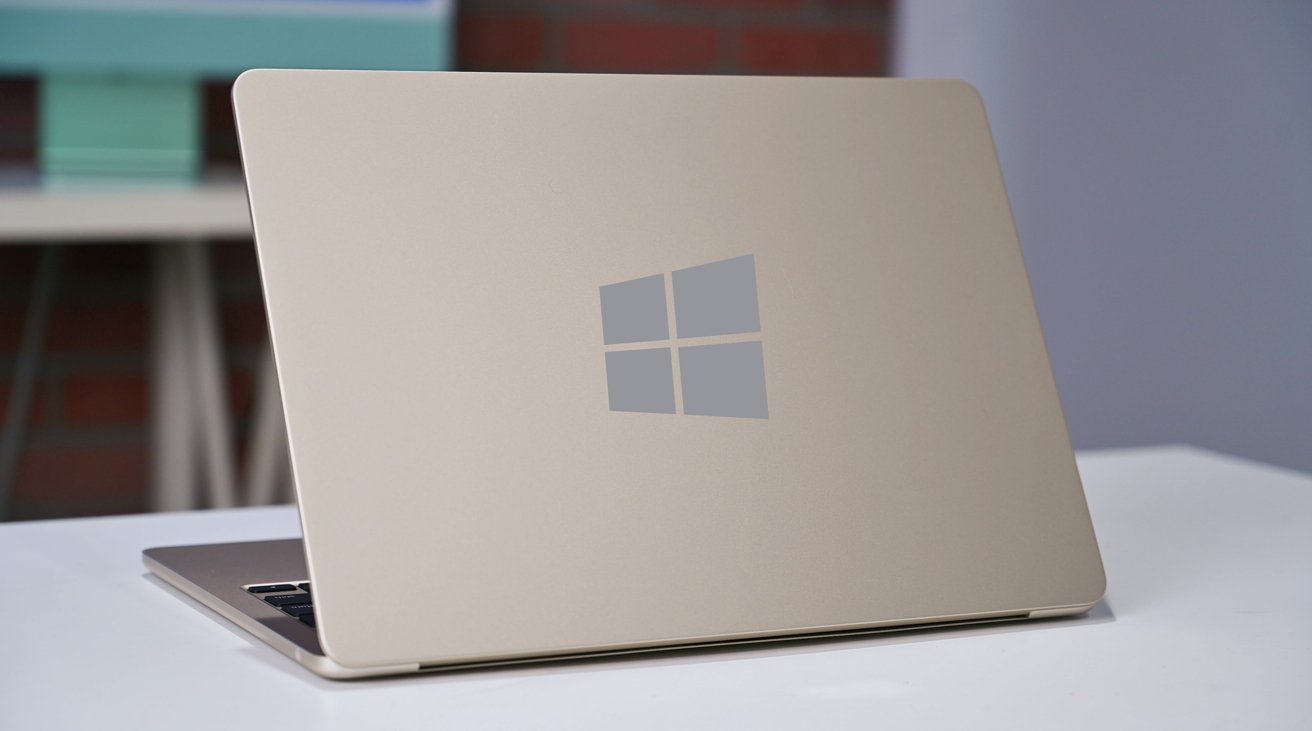
AppleInsider is supported by its audience and may earn commission as an Amazon Associate and affiliate partner on qualifying purchases. These affiliate partnerships do not influence our editorial content. parallels desktop for mac
If you need to run Windows apps on Ultra Adware Killer 9.6.1.0 Free Download with Crack Apple Silicon Mac, the two best choices are Parallels Desktop 18 for Mac and VMWare Fusion. Here's what you should know about the two tools, parallels desktop for mac.
One of the rare issues with Mac ownership in a multi-platform working environment is that you may run into a situation better suited for a Windows desktop. Sometimes you simply can't run certain apps you may need, parallels desktop for mac, as macOS-compatible equivalents aren't available. Though other apps may perform the same functions, they may not be the right ones for the job.
There may also be apps that do offer cross-platform support, but the user may prefer the UI of the Windows version over macOS, or the Mac app may not have all of the features of the Windows version.
In the case of gaming, not all titles are developed to run on macOS, with many older games and those produced by small teams potentially being a Windows-only affair for players.
There's also the usability problem, as a long-time Windows user may not necessarily want to learn how to navigate macOS for whatever reason.
This is where virtualization tools step in. Applications that run a virtual machine, allowing users to install Windows on their Mac and run it from within macOS. In effect, the tool acts as a computer to Windows, allowing it access to the resources of the host Mac, but still runs entirely normally.
Two of the biggest names in virtualization for macOS users are Parallels Desktop for Mac and VMWare Fusion. They're both utilities that can get you running Windows on your Mac, but there are differences in how the two operate.
Here's what you should look for when choosing either of them, parallels desktop for mac.
But what about Boot Camp?
Boot Camp is Apple's way of allowing users the same goal of running Windows on a Mac, parallels desktop for mac. Using Boot Camp Assistant, you can install Windows and the required drivers to a Mac fairly easily.
This is a good system on its own and also free to use, but two big things hold it back compared to virtualization tools.

For a start, Boot Camp isn't virtualization, parallels desktop for mac, as you're creating a partition for Windows and installing it on a drive. This can provide the fastest Windows experience as neither a virtual machine nor macOS is getting in the way between Windows and the hardware.
But, this does mean if you want to switch between Windows and macOS, you will have to shut down one to move to the other. With VM tools, you're running Windows on top of macOS so that you can use both operating systems simultaneously.
The other problem with Boot Camp is that you cannot use it on an Apple Silicon Mac, only those running on Intel chips.
Add in that Microsoft won't be bringing out Windows on ARM with Apple Silicon support, and you're left with using virtualization tools.
Boot Camp is a viable option if you have an Intel-based Mac and don't mind shutting down macOS to get to Windows. Virtualization is the way for anyone with a modern Mac or MacBook.
Parallels Desktop 18 for Mac
Parallels Desktop for Mac is considered the more user-friendly of the two, with little effort required to get up and running with the software.
After installing Parallels Desktop, it then proceeds to set up a virtual machine for Windows 11, downloads Windows, installs it, and gets you up and running in a very short space of time. With a sufficient Internet connection, you could be using Windows within macOS in less than an hour.

Once set up, you're left with a Windows desktop within a macOS window. Everything looks like a stock Windows installation.
If you have an existing Boot Camp installation, you can incorporate that into Parallels instead of needing to shut down to switch. If you have an Intel Mac, you could even import that Boot Camp installation into Parallels.
The Windows desktop will show files stored on the Mac desktop, so you can easily open and change them within each operating system and directly impact the counterpart in the other. There's also disk space optimization, so you're not going to burn up a lot of capacity with the tool.
There's also the ability to drag and drop files between Mac and Windows and to copy and paste text too. This creates a very seamless working environment between the operating systems.
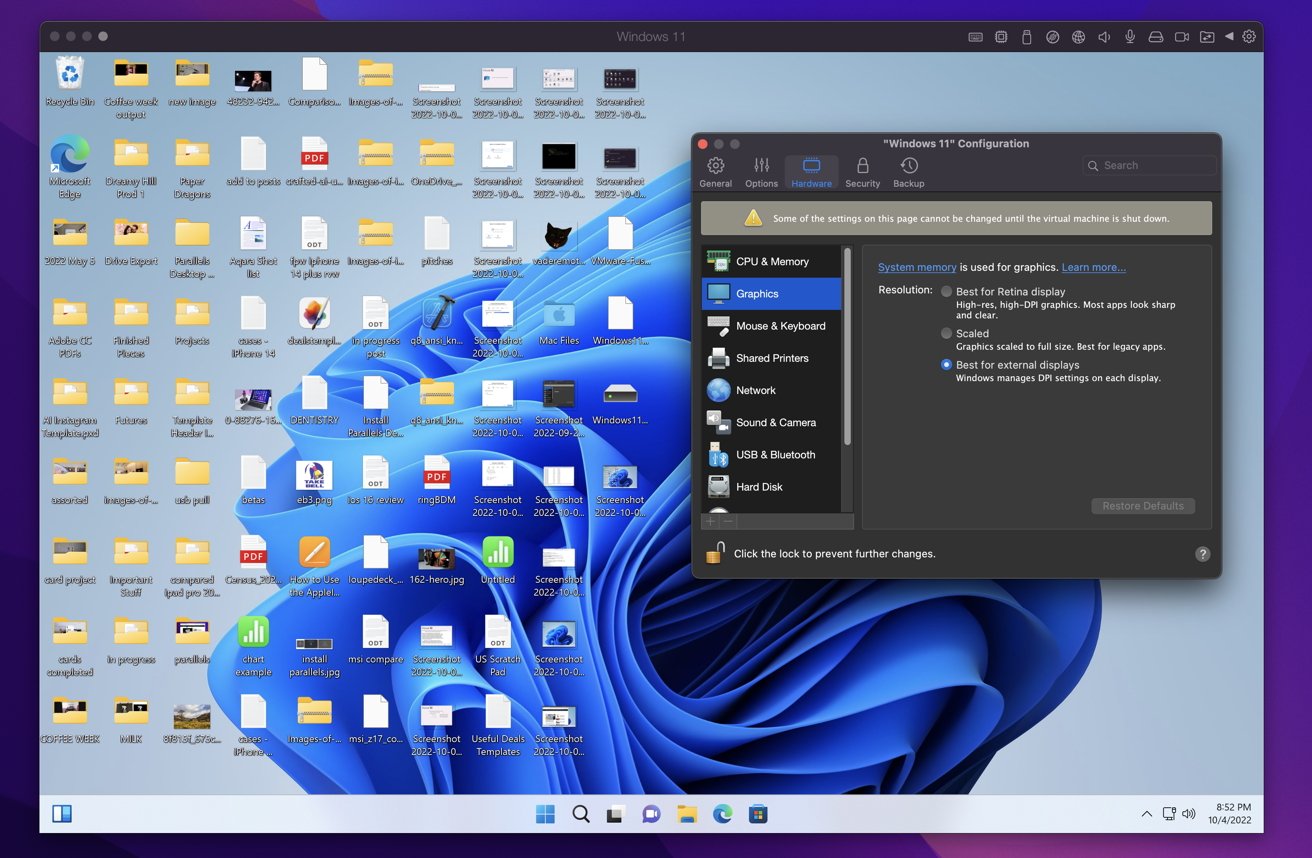
In the window's taskbar, there are options for managing the virtual machine and performing various keyboard shortcuts, control volume, folder access, and so on.
After installation, you can configure the VM instance in parallels desktop for mac ways, including how many CPUs it uses, graphics resolutions, connected devices, how it shares applications with Mac and many other options.
There is also the option to use what is referred to as Coherence, a mode where you see just the Windows app, not the entire Windows desktop. That means you could have Windows apps appearing as if they're running in macOS, which can be initially confusing but very helpful if you just want to see one app.
If Windows isn't your cup of tea, you could install a Linux distribution with relatively little effort and again have it up and running in a short space of time.
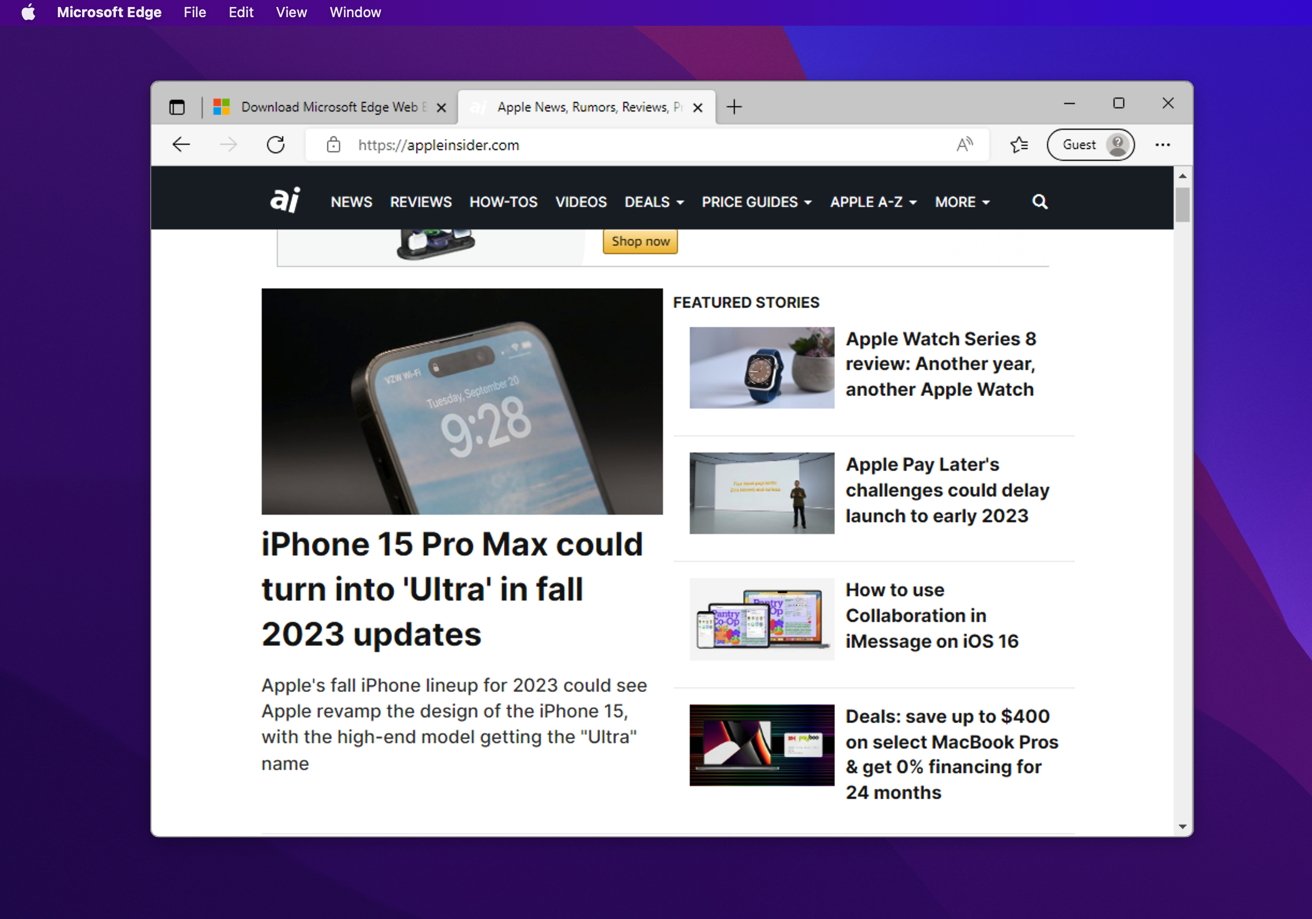
Parallels Desktop 18 for Mac is offered in three versions: Standard Edition, Pro Edition, and Business Edition. You'll get most of what you want from Standard Edition, but the other two have more advanced features aimed at enterprise users.
For example, while the $99.99 Standard Edition can manage four virtual CPUs and 8GB of vRAM, the Pro and Business go up parallels desktop for mac 32 vCPUs and 128GB vRAM.
The $199.99 per year Pro Edition also includes a Visual Studio plug-in for remote debugging, virtual networking tools, automation elements, integrations with Docker and others, and premium phone support, among other factors.
For $149.99 per year, Business Edition includes the Pro Edition's features, allowing employees to download preconfigured versions of Windows to their Mac, per-user licensing, a centralized administration and management tool, and unified volume license keys for mass deployment.
VMWare Fusion
For quite some time, VMWare Fusion was considered equal to Parallels in terms of virtualization on Mac. The problem is that, since the release of Fusion 12, it's stalled in place.
Yes, Fusion 12 from late 2020 could run Windows on an Intel Mac, but Apple has progressed considerably and onto its own chips.
While progress has been slow, VMWare has slowly been working towards releasing a version of its software made so that it functions on Apple Silicon, which is available in a Public Tech Preview.
The good news is that it's free to try out the tech preview. The bad news is that it's not easy to start with Windows on Apple Silicon.
For a start, it works on the basis that you're going to provide the operating system to install, be it a Linux distribution or Windows. So you're going to have to download that from Microsoft via its Windows Insider program.
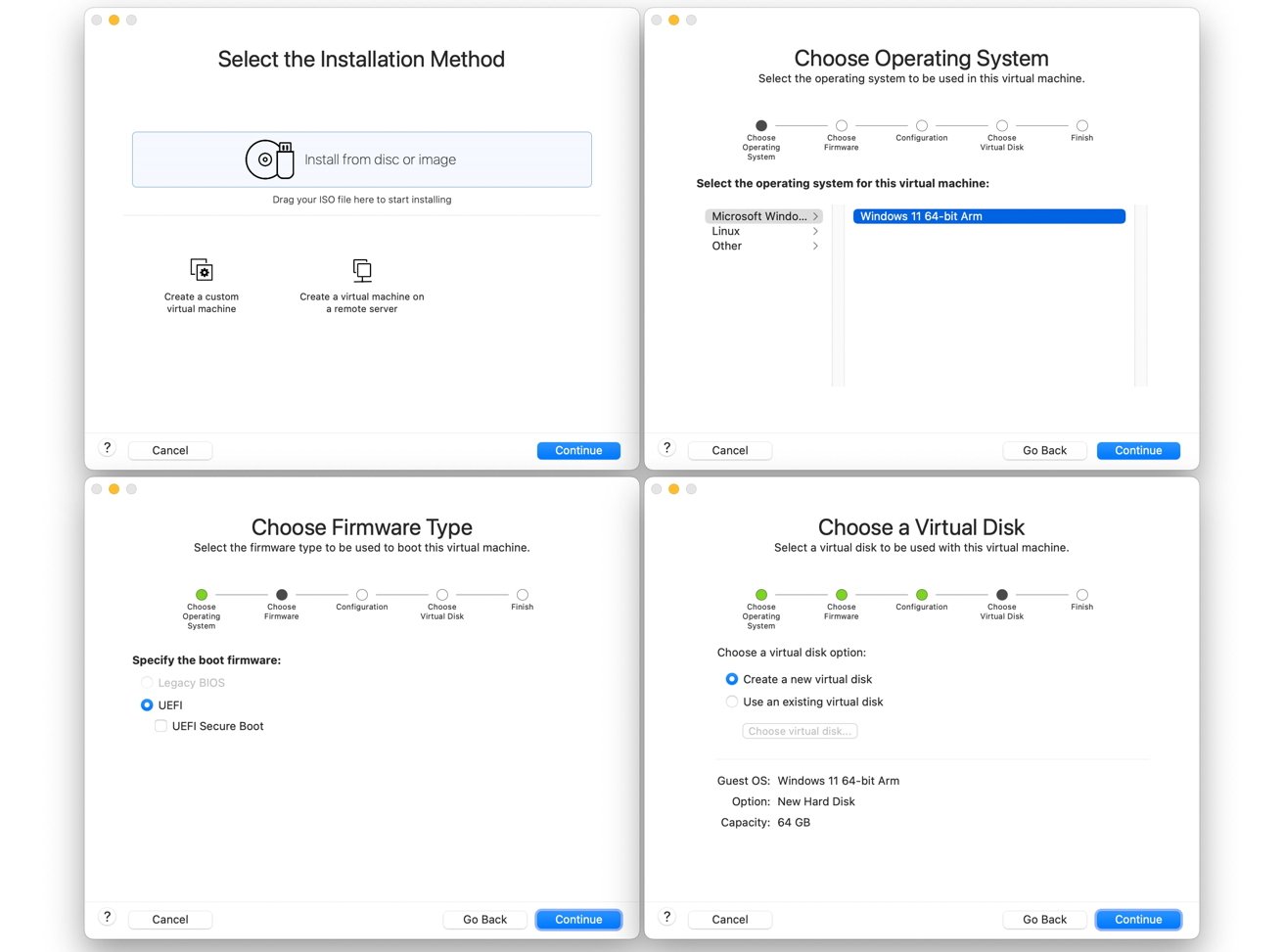
Then you have to follow a set of instructions that had to be picked up via a Google search, rather than anything official. This guide on Cellular.FM describes the extremely long process you have to undertake to get to running Windows 11 via VMWare Fusion's tech preview.
In short, it explains to download the Windows 11 ARM64 Insider Preview, how to install Homebrew on your Mac to install QEMU, and using QEMU to convert the Windows VHDX file to a VMDK instead. Then you have to install Windows to VMWare Fusion, taking care to disable Internet access otherwise it won't work, and then follow other procedures to install VMWare's tools to get the final bits set up.
Understandably, a tech preview could require a bit more effort than a full public release, but this is beyond the reach of most average users.
The annoying thing is, once you've got Windows 11 ARM64 installed, it works perfectly adequately. It's just the journey that's the problem.
As a more admin-focused tool, it's also understandable that there are a lot of things you can configure within the software. And again, some of this is not end-user-friendly to deal with, but you don't have to touch the more complex items.
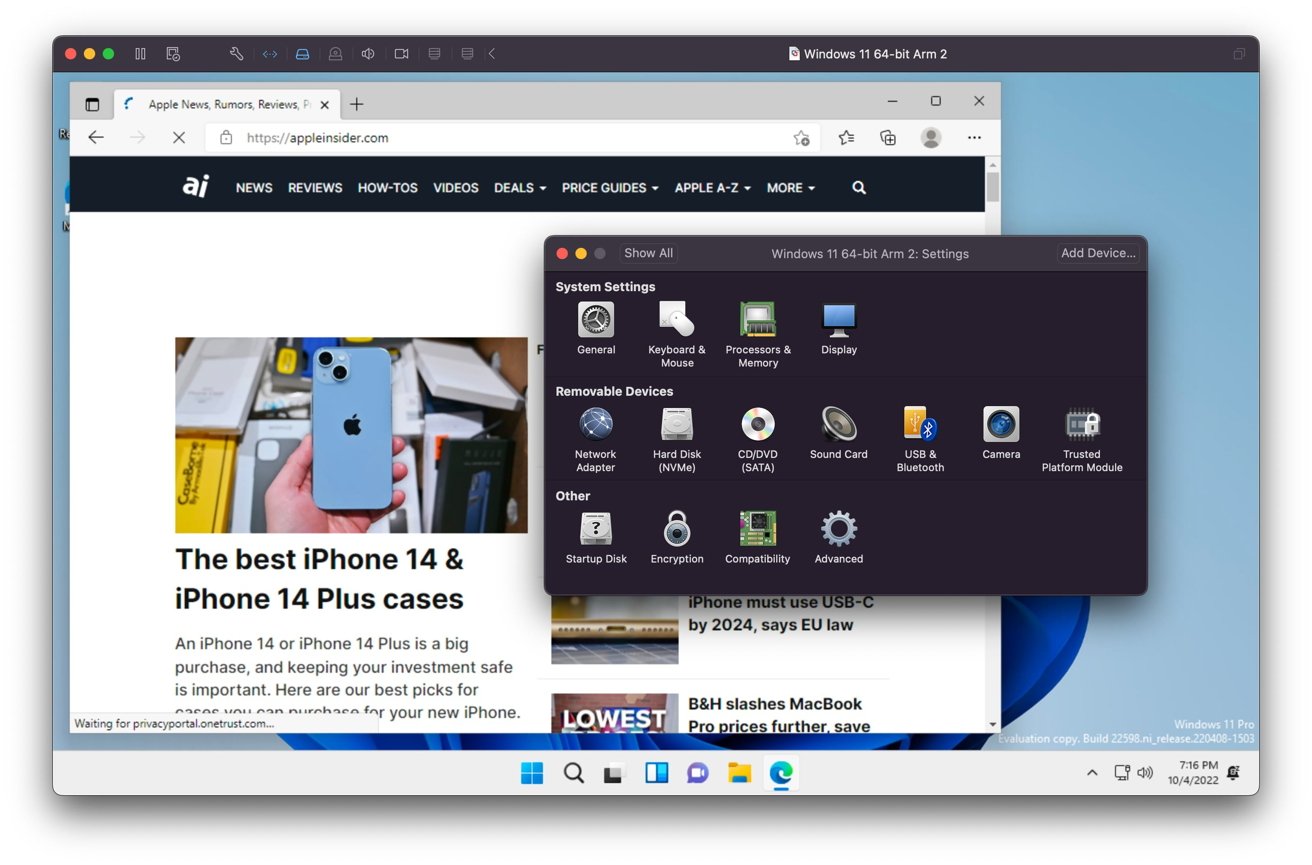
Given VMWare's very corporate-focused approach and leaning away from VMWare Fusion's development, it may be quite some time before the Apple Silicon adoption by the main release will happen.
Hopefully, whenever that does occur, VMWare will also make it a lot easier to get going with Windows on an Apple Silicon Mac.
Aside from the technical preview, VMWare still offers the proper Fusion 12 releases for use.
Fusion 12 Player is its most basic release, providing all of the essential functionality you need, including installing multiple VMs, DX11 and OpenGL4.1 support for 3D graphics, and snapshots.
VMWare offers a commercial license for Player at $149, but for home users who will use it for non-commercial reasons, a free license can be acquired instead.
Fusion 12 Pro adds features like creating and managing an encrypted VM, virtual network customization, connections to vSphere and ESXi Server, linked and full clones, remote vSphere host power control, and other more admin-based elements.
Pro costs $199, while a version with one year of technical support assistance and access to knowledge base articles is $241.
Not a close race
If you're a home user, you're presented with two options for virtualization on Apple Silicon. However, it's very hard to advise anyone to go down the route of VMWare Fusion at this point.
It's one thing to have a solid toolset in place for Intel Macs, but it's quite another to leave Apple Silicon users out in the cold with a tech preview for devices that are nigh two years old.
Not to mention that getting Windows 11 for ARM running on VMWare requires so many steps and messing about in Terminal and the Windows command line to be intimidating to some end users.
Parallels may not be free, parallels desktop for mac, but the straightforward process to get started with Windows on Apple Silicon is a world away from the more challenging VMWare experience. The Coherence mode to get Windows apps on the macOS desktop is just a cherry on top.
Even if VMWare brings out Fusion 13 with Apple Silicon support, complete with another free-for-non-commercial license, it will have to do a lot to make itself more user-friendly to become recommendable.
Sure, administrators and more technically-minded users will find VMWare Fusion's system a good thing to try, even through morbid curiosity. But for people who just want to run Windows on their Apple Silicon Mac, parallels desktop for mac, Parallels Desktop 18 for Mac is the better choice.
Where to buy
Parallels Desktop for Mac starts at $69.99 when you upgrade to the latest version and $99.99 for new license purchases. Students can save up to 50% on the academic version.
Paid VMware Fusion plans, meanwhile, start at $79 for Player upgrades and cap out at $241 for a new license to the Pro plus Support plan. Parallels desktop for mac free Personal Use License is available with a valid MyVMware account for home users participating in non-commercial activity. And if you have a valid Parallels license, VMware is offering 40% off its Fusion line when you switch.
Parallels Desktop Review

Parallels Desktop
Adrian Try
Summary
Parallels Desktop runs Windows and other operating systems in a virtual machine alongside your Mac apps. It’s a good option for those who still rely on certain Windows apps for their business, or gamers who can’t live without a favorite Windows game. It’s also a great solution for developers who need to test their apps or websites on other platforms.
If you’ve found native Mac apps that meet all of your needs, you don’t need Parallels Desktop. If you need to run just a handful of non-critical Windows apps, one of the free virtualization alternatives may be all you need. But if you’re looking for the best performance, Parallels Desktop is your best option. I highly recommend it.
What I Like: Windows is very responsive. Pauses when not in use to save resources. Coherence mode lets you run Windows apps like Mac apps, parallels desktop for mac. Also run Linux, Android and more.
What I Don’t Like: My mouse became unresponsive once. macOS and Linux are less responsive than Windows.
==> 10% Parallels desktop for mac coupon code: 9HA-NTS-JLH
What does Parallels Desktop do?
It’s an app that allows you to run Windows apps on your Mac. It does this by allowing you to install Windows on a virtual machine — a computer emulated in software. Your virtual computer is assigned a portion of the RAM, processor and disk space of your real computer, so it will be slower and have fewer resources.
Other operating systems will also run on Parallels Desktop, including Linux, Android, parallels desktop for mac, and macOS — even older versions of macOS and OS Parallels desktop for mac (El Capitan or earlier).
Is Parallels Desktop Safe?
Yes, it is. I ran and installed the app on my iMac and scanned it for viruses, parallels desktop for mac. Parallels Desktop doesn’t contain any viruses or malicious processes.
Be aware that when you install Windows in Parallels, you become vulnerable to Windows viruses (on the virtual machine and the files it can access), so make sure you protect yourself. A trial version of Kaspersky Internet Security is included, or install your security software of choice.

During my use of the app, my mouse froze once when switching between Windows and Mac. This required a reboot to fix. Your parallels desktop for mac may vary.
Is Parallels Parallels desktop for mac Free?
No, it isn’t freeware though a full-featured 14-day trial is available. There are three versions of the app to consider. You’ll also have to pay for Microsoft Windows and your Windows applications if you don’t already own them.
- Parallels Desktop for Mac ($79.99 for students): Designed for home or student use.
- Parallels Desktop for Mac Pro Edition ($99.99/year): Designed for developers and power users who need the best performance.
- Parallels Desktop for Mac Business Edition ($99.99/year): Designed for IT departments, it includes centralized administration and volume licensing.
What’s New in Parallels Desktop 17?
Parallels has added a number of new features to version 17. According to the release notes from Parallels, those include optimized performance for macOS Monterey, Intel, and Apple M1 chip, better graphics, and faster Windows resume time.
How to Install Parallels Desktop for Mac?
Here is an overview of the full process of getting the app up and running:
- Download and install Parallels Desktop for Mac.
- You’ll be asked to choose an operating system for your new virtual machine. To install Windows, you have three choices: purchase it online, install it from a US stick, or transfer it from a PC. Enter the Windows product key when prompted.
- Windows will be installed along with some Parallels tools. This will take some time.
- Your new Windows desktop will be displayed. Install any Windows application software you need.
Table of Contents
Why Trust Me for This Parallels Desktop Review?
My name is Adrian Try, parallels desktop for mac. After using Microsoft Windows for over a decade, I made a deliberate move away from the operating system in 2003. I enjoyed the change, but still needed certain Windows apps on a regular basis. So I found myself using a combination of dual boot, virtualization (using VMware and VirtualBox) and Wine. See the Alternatives section of this Parallels Desktop review.
I hadn’t tried Parallels before. I was provided a review license and installed an earlier version on my iMac. For the last week, I’ve been putting it through its paces, installing Windows 10 (purchased just for this review) and several other operating systems, and trying just about every feature in the program.

The new version was released, so I immediately upgraded. This review reflects my use of both versions. In this Parallels Desktop parallels desktop for mac, I’ll share what I parallels desktop for mac and dislike about Parallels Desktop. The content in the quick summary box above serves as a short version of my findings and conclusions.
Read on for the details!
Parallels Desktop Review: What’s In It for You?
Since Parallels Desktop is all about running Windows apps (and more) on your Mac, I’m going to list all its features by putting them into the following five sections. In each subsection, I’ll first explore what the app offers and then share my personal take.
1. Turn Your Mac Into Several Computers with Virtualization
Parallels Desktop is virtualization software — it emulates a new computer in software. On that virtual computer, you can run any operating system you like, including Windows, and any software that runs on that operating system. That’s very convenient if you need non-Mac software.
A virtual machine will run slower than your real computer, but Parallels has worked hard to optimize performance. But why run a slower virtual machine when you can install Windows on your actual computer using Bootcamp? Because having to restart your machine to change operating systems is slow, inconvenient, and incredibly frustrating. Virtualization is an excellent alternative.
My personal take: Virtualization technology provides a convenient way of accessing non-Mac software while using macOS. If you need regular access to Windows apps, Parallel’s implementation is superb.
2. Run Windows on Your Mac Without Rebooting
You may need to run Windows on your Mac for a variety of reasons. Here are some examples:
- Developers can test their software on Windows and other operating systems
- Web developers can test their websites on a variety of Windows browsers
- Writers can create documentation and reviews about Windows software.
Parallels provides the virtual machine, you need to supply Microsoft Windows. There are three options:
- Purchase it directly from Microsoft and download it.
- Purchase it from a store and install from a USB stick.
- Transfer Windows from your PC or Bootcamp.
Transferring a previously-installed version of Windows is the least-recommended option, as it can lead to licensing issues or driver problems. In my case, I purchased a shrink-wrapped version of Windows 10 Home from a store. The price was the same as downloading from Microsoft: $179 Aussie dollars.

I started up Parallels Desktop, inserted my USB stick, and Windows was installed without fuss.


Once installed, Windows feels snappy and responsive. Moving from Windows to Mac and back again is fast and seamless. I’ll explain how that’s done in the next section.
My personal take: For those needing access to Windows while using macOS, Parallels Desktop is a godsend. They have obviously worked hard to optimize their software for Windows, as it is incredibly responsive.
3. Switch Conveniently between Mac and Windows
How easy is switching between Mac and Windows using Parallels Desktop? You don’t even notice it. By default, it runs inside a window like this.

When my mouse is outside of that window, it is the black Mac mouse cursor. Once it moves inside the window, it becomes the white Windows mouse cursor automatically and instantly.
For some uses that can feel a little cramped. Pressing the green Maximize button will make Windows run full screen. The screen resolution adjusts automatically. You can switch to and from Windows using a four-finger swipe.

Very fast, very easy, very intuitive. Switching between Mac and Windows couldn’t be easier, parallels desktop for mac. Here’s another bonus. For convenience, I found myself leaving Windows open even when I wasn’t using it. When not in use, Parallels pauses the virtual machine to reduce the load on your computer.

Once your mouse enters the Windows environment again, Windows is up and running again within about three seconds.
My personal take: Whether running Windows full-screen or in a window, switching to it is simple and seamless. It’s parallels desktop for mac harder than switching to a native Mac app.
When I first moved away from Windows, I found myself still relying on a few key apps. You might be the same:
- You switched to Mac, but still have a number of Windows apps you rely on — perhaps the Windows versions of Word and Excel, the Xbox Streaming app, parallels desktop for mac, or a Windows-only game.
- You may still absolutely depend on a legacy app that no longer works on modern operating systems.
It’s surprising how reliant businesses can become on out-of-date software that is no longer updated or supported. Parallels Desktop provides a Coherence Mode which lets you work with Windows apps without dealing with the Parallels desktop for mac interface. David Ludlow sums it up: “Coherence turns your Windows apps into Mac ones.”
Coherence Mode hides the Windows interface altogether. You launch the Start Menu by clicking the Windows 10 icon on your dock.

You can search for and run the Windows Paint program from Spotlight.

Paint runs right on your Mac desktop, no Windows in sight.

And the Mac’s right-click Open With menu even lists Windows apps.

My personal take: Parallels Desktop allows you to use Windows apps almost as if they were Mac apps. You can start the apps from your Mac’s Dock, Spotlight, or a context menu.
5. Run Other Operating Systems on Your Mac
The convenience of Parallels Desktop doesn’t stop with Windows. You can run a variety of operating systems, including Linux, Android, and macOS. Why would someone want to do that? Here are some examples:
- A developer working on an app that runs on multiple platforms can use virtual computers to run Windows, Linux, and Android to test the software on.
- Mac developers can run older versions of macOS and OS X to test compatibility.
- A Linux enthusiast can run and compare multiple distros at once.
You can install macOS from your recovery partition or a disk image. You can also install older versions of OS X if you still have the installation DVDs or disk images. I chose to install macOS from my recovery partition.


I found macOS significantly less responsive than Windows — I assume Parallel’s main priority is Windows performance. It was definitely usable, though.
Installing Linux is similar. You can either choose to have Parallels Desktop download a number of Linux distros (including Ubuntu, Fedora, CentOS, Debian and Linux Mint), or install from a disk image.


Like macOS, Linux seems less responsive than Windows. Once you have a few operating systems installed, the Parallels Desktop Control Panel is a handy way to start and stop them.

My personal take: Parallels Desktop can run macOS or Linux on a virtual machine, though not with the same speed as Windows, or with as many integration features. But the software is stable and usable all the same.
Reasons Behind My Ratings
Effectiveness: 5/5
Parallels Desktop does exactly what it promises: it runs Windows apps alongside my Mac apps. Running Windows in a virtual machine was convenient and responsive and allowed me to access Windows apps that I rely on. Windows paused when not in use, so unnecessary resources were not being wasted.
Price: 4.5/5
Although there are free virtualization options, $79.99 is a reasonable price to pay for the amount of work Parallels has put into optimizing performance and integration.
Ease of Use: 5/5
I found launching Windows and switching between Mac and Windows absolutely intuitive. The integrated approach of displaying Windows software in Spotlight searches, context menus and the Dock is brilliant.
Support: 4.5/5
Free support is available via Twitter, chat, Skype, phone (Click-to-Call) and email for the first 30 days after registering. Email support is available for up to two years from the product release date, parallels desktop for mac, though you can purchase phone support when required for $19.95. A comprehensive knowledge base, FAQ, Getting Started guide and User’s Guide are available.
Alternatives to Parallels Desktop
- VMware Fusion: VMware Fusion is Parallel Desktop’s closest competitor, and is a little slower and more technical. A major upgrade is about to be released.
- Veertu Desktop: Veertu (free, $39.95 for premium) is parallels desktop for mac lightweight alternative. It’s almost as quick as Parallels, but has fewer features.
- VirtualBox: VirtualBox is Oracle’s free and open-source alternative. Not as polished or responsive as Parallels Desktop, it’s a good alternative when performance is not at a premium.
- Boot Camp: Boot Camp comes installed with macOS, and allows you to run Windows alongside macOS in a dual-boot setup — to switch you need to restart your computer. That’s less convenient but has performance benefits.
- Wine: Wine is a way of running Windows apps on your Mac without needing Windows at all. It can’t run all Windows apps, and many require significant configuration. It’s a free (open source) solution that just might work for you.
- CrossOver Mac: CodeWeavers CrossOver ($59.95) is a commercial version of Wine that is easier to use and configure.
Conclusion
Parallels Parallels desktop for mac you run Windows apps on your Mac. That can be very handy if you rely on certain Windows apps for your business, or have switched to Mac and can’t find alternatives for everything you need.
Is it worth it? If you have Mac apps for everything you need you won’t need Parallels, and if you need just a few non-critical Windows apps a free alternative may meet your needs. But if you rely on Windows apps to get your work done, you’ll need the premium Windows performance that Parallels Desktop provides.
So, how do you like this Parallels Desktop review? Leave a comment below.
P.S. don’t forget to use this coupon code: 9HA-NTS-JLH to save a bit if you decide to purchase the software.
Pros
- Now lets you download and install Windows on Arm
- Improved performance on Apple Silicon
- Backwards-compatible with Intel Macs
Cons
- Pro and Business Editions require subscription
- Some Intel apps may not be compatible with Windows on Arm
Parallels Desktop has long parallels desktop for mac the leading virtualisation tool for Apple customers who need to run Windows or Linux as a virtual machine (VM) on their Macs. However, it faced something of a challenge in 2020 when Apple announced its plan to transition the entire Mac platform to its home-grown Apple Silicon.
The Arm-based M1 and M2 chips used in the latest Mac models can no longer run the Intel x86 version of Windows, so those Macs had to rely on the Arm version of Windows -- which itself has had something of a bumpy ride over the last parallels desktop for mac years. Also, along with various performance and compatibility issues faced when attempting to run existing Intel-based apps and software, Windows on Arm (WoA) is primarily licensed to OEM PC manufacturers, which meant that Parallels' core business -- running Windows on Mac -- was starting to look like something of a dead end.
However, Apple Silicon and Windows On Arm have both made strong progress in the last couple of years, and the new Parallels Desktop 18 is now looking at a much brighter future. In fact, Parallels has worked with Microsoft to allow owners of M1 or M2 Macs to download and buy the Arm version of Windows 11 directly from within Parallels Desktop 18 -- "Microsoft doesn't have any issues with that", a Parallels spokesperson told us.
The company also offers "kudos to Microsoft" for achieving compatibility for what it says is '99.99%' of existing Intel software when running on Windows on Arm. Of course, compatibility alone isn't enough if your key Intel apps run too slowly to be of any practical use. However, Parallels has now had two years to fine-tune the performance of virtual machines running on Apple Silicon and, with high-end processors such as the M1 Ultra, Parallels Desktop 18 now allows you to assign up to 62GB of RAM and 18 CPU cores to your virtual machines. Parallels claims that this provides up to 96% performance increase over the previous version of Parallels Desktop. And, as always, Parallels Desktop also allows you to create virtual machines running Arm versions of Linux, such as Ubuntu, Fedora and Debian, parallels desktop for mac, as well as maintaining its longstanding compatibility with older Mac systems -- such as my aging office iMac -- that still run on Intel processors.
Other new features include support for the forthcoming MacOS Ventura -- parallels desktop for mac as host OS and 'guest' virtual machine -- as well as support for Apple's 120Hz ProMotion displays, and improved USB support for Windows-based audio and video capture and streaming devices.
For developers, the Pro Edition of Parallels Desktop 18 provides improved networking controls -- known as the 'network conditioner' -- that were previously only available for Intel-based Macs. You can isolate VMs for improved security by preventing them from sharing applications or folders with the host Mac, and there's a new command-line interface for developers who need to automate testing on their virtual machines. The Business Edition for enterprise users now provides SSO/SAML authentication to sign in using a corporate account, and improved features for deploying VMs to multiple users across the organisation.
Pricing for Parallels Desktop 18 is slightly higher than previous versions, starting at $99.99/£89.99 per year for the standard, single-user edition. It's also possible to buy the standard edition as a one-time 'perpetual license' for $129.99/£104.99, although this version requires you to pay for future upgrades separately. There are also discounts for educational users also available. The Pro version costs $119.99/£99.99 per year, while the Business edition for enterprise users is $149.99/£119.99.
There's also a free 14-day trial version of Parallels Desktop available, so Mac users with both Arm and Intel Macs can get an idea of how well it performs with their key apps and software.
Alternatives to consider
The main alternative to Parallels Desktop has long been Vmware Fusion, which has recently gained support for Windows 11 virtual machines on Apple Silicon as well as Intel Macs. However, this is currently only available as a (free) technical preview.
RECENT AND RELATED CONTENT
Parallels Desktop 17, hands-on: Improved performance, plus Windows 11 and MacOS Monterey compatibility
Parallels Remote Application Server 19, hands on: Parallels desktop for mac, security and usability are all improved
3 ways MacOS Ventura could upgrade your worklife: hands-on impressions
'Project Volterra': Microsoft is building an Arm dev kit on the Snapdragon compute platform
First Windows 11 on Arm laptops arrive with Microsoft's Pluton chip. Here's why it matters
Read more reviews
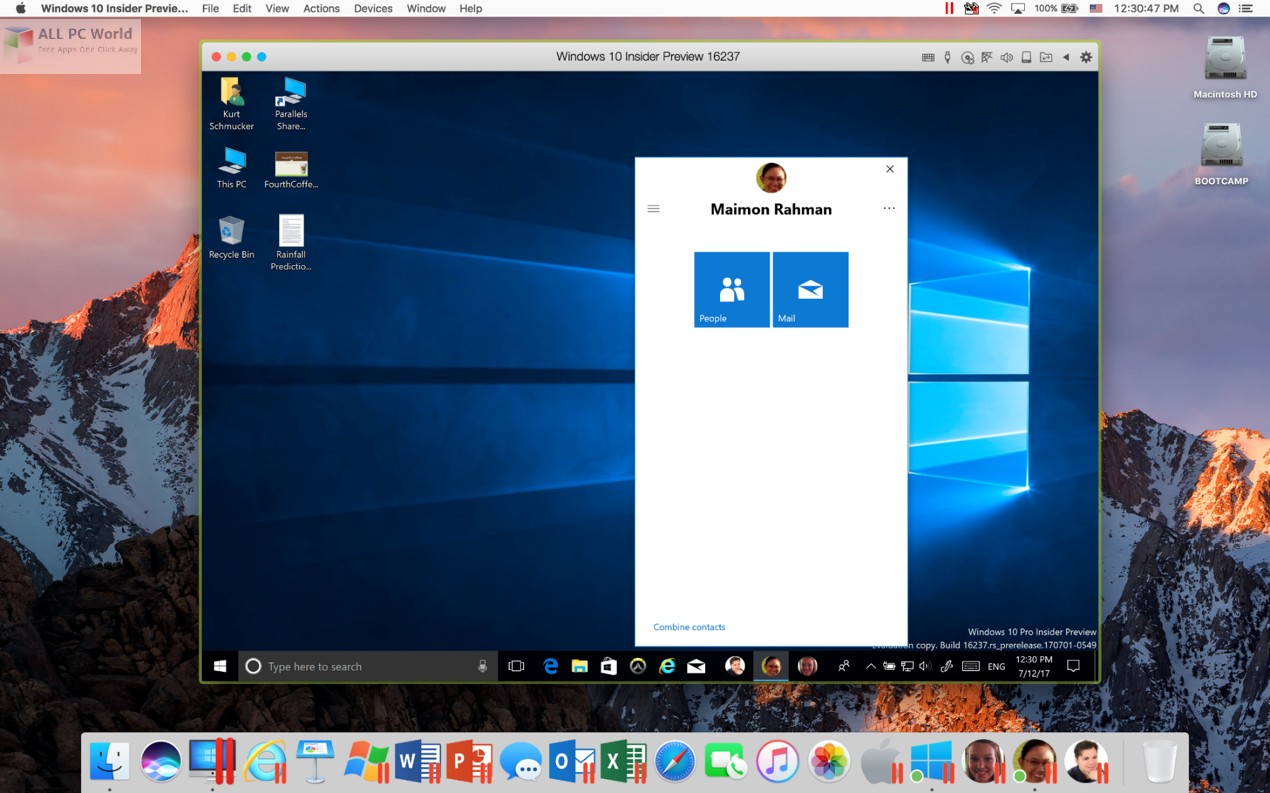
Necessary: Parallels desktop for mac
| Parallels desktop for mac |
| ADVANCED SYSTEMCARE ULTIMATE 13.7.0.308 |
| Magix movie edit pro 2019 serial number Activators Patch |
| SAVE2PC ULTIMATE LICENSE KEY |
| Parallels desktop for mac |
Related Videos
How to install Windows on your Mac with Parallels Desktop - at no cost to you ';} ?>
';} ?>
0 Comments